15 Surprising Benefits of a Ketch Rig (and 7 Cons)
If you're trying to figure out whether the ketch rig is for you, there are a couple of important factors to consider. In this article, I'll sum up the most important benefits.
What are the benefits of a ketch rig? Since the sail area is divided over multiple sails, the ketch is more easily managed and is great for single-handed sailing. It offers more versatility in sail plan, and is known to handle very well in heavy winds. The ketch rig is an especially effective rig for larger boats (40ft and up).
Just a quick recap: the ketch is a two-masted sailboat that has a mainmast (front) and shorter mizzenmast (aft or back). Both masts carry a mainsail. The sail on the mizzenmast is also called the jigger.
Your mizzensail provides all kinds of benefits. There are some really creative ways to put your mizzenmast to use. Read on to learn what those are.


On this page:
The ideal rig for long-distance offshore cruising, ketches generally perform better in downwind conditions, smaller sails are easier to manage, easier reefing, using multiple sails allows for more control, more versatile sail plan options, you gain a spare sail, more balanced sailing, superior sail plan in heavy winds, comfort over speed, less stress on the rigging, variety of mizzenmast uses, the air rudder, free riding sail at anchor, incredibly fast in right conditions, disadvantages of the ketch rig, in conclusion.
All in all, the ketch rig is widely known as one of the best rigs for long-distance cruising . There are multiple reasons to back up that claim, and we'll go over all of them one by one below. But the most important reason is that the ketch is incredibly comfortable, both in handling, maneuvering, operating, and the ride itself. This increased comfort is largely thanks to the extra sail aft, the mizzensail, which provides a better power balance.
So who's it for?
The ketch is especially great for long-distance cruisers that face rough waters and heavier winds and are short-handed. For example, couples that want to sail around the world together, or liveaboards that go on long holidays or expeditions. It's also a great family cruiser, since you can sail a larger boat without needing additional crew members or having to operate humongous sails.
While with the Marconi rig the main and jib get in each other's way on downwind runs, the ketch rig has far fewer problems. The mizzensail and mainsail can work together seamlessly and are far more efficient with most points of sail, except of course when sailing very close to the wind. But even then, the Bermuda rig and ketch can go neck-to-neck and the gap in performance isn't necessarily enormous. Unless you're a racer, the ketch is a really good alternative to the Bermuda rig, and most people should at least consider it.
The ketch is a very good single-handed rig, especially for larger boats (40ft and up). Using smaller but more sails allows you to have more sail area, while it's still manageable for one person. Also, smaller sails are easier to handle in heavier winds . Splitting up your sail area is just a great way to keep things in check, even with a small crew of just one or two people.
Because you have more (and mostly smaller) sails, reefing becomes easier. There's less stress on the sails, and you can reef down gradually, in phases, moving through your sails one by one. This ensures comfortable reefing and results in less speed reduction.
Another great tip I've read somewhere is that you can even quickly drop your main when the winds come in. Instantly, you're storm proof, while maintaining speed and course.
The ketch rig has three primary sails instead of two. This provides all kinds of benefits, and there are a couple of really surprising ones, which I'll come to later on. But the most important one is that you gain more control. The mizzensail provides more control over your stern.
Also, with the additional sail, you get a lot more trimming options for all conditions, allowing you more precise control for each point of sail and with any wind.
The extra sail also provides more versatile sail plan options. You have a broader operating range. There are more sails to put up with light airs, but also more sails to take down when things get rough. You can reef in all kinds of different combinations, and even take down the main if you have to. Which brings me to my next point.
This provides A LOT of benefits. For example, if you need to perform maintenance on your main, you can simply take it down, and continue sailing without losing control or a lot of speed. The ketch can sail on all points of wind with the main down (or the mizzen or jib). You have a spare sail, which will come in handy.
The mizzensail has a major upside you just won't get with the Bermuda sloop rig. The mizzensail balances the jib.
Sailing "jib and jigger" means just using your mizzen and jib, and leaving the mainsail down.
I've heard that this sail plan is very well-balanced, and allows you to self steer in a way. You could theoretically even use it as an temporary alternative to your autopilot, should it break down.
Thanks to its more balanced sail plan, the ketch rig is a much more comfortable ride in heavier winds, and many sailors praise the ketch for precisely that. Taking down the mainsail, sailing just the jigger and jib, provides a sort of instant storm sail plan that at the same time offers a lot more control than the single stormsail you'd usually put up on a Bermuda rig instead of the mainsail.

I think it's clear by now that the ketch is maybe the ultimate cruising rig. If you value your comfort, the mizzen offers some incredible benefits. The well-balanced output of this rig and the enormous variety in sail trim options allow for a smooth ride in almost all conditions.
However, you do pay a (minor) price for all this luxury: speed. The ketch is inevitably slower than the leaner Bermuda rig. However, on a downwind run, the ketch will still satisfy: there's plenty of sail area to gain some nice momentum.
Reducing sail size means you don't have to put as much stress on the rigging and you could use shorter masts, making them stronger. The difference in mast length isn't huge, but the forces on the mast grow exponentially with length. So a bit shorter mast makes a big difference.
In turn, the stress on the rigging is also reduced, which can lead to less wear, resulting in lower maintenance costs.
Stress on the rigging seems to be the major disadvantage of the Marconi rig.
Another rig that's a bit 'softer' is the gaff rig . The gaff rig is better suited for inland, calm waters instead of long term cruising, but can be another good alternative to the uptight Bermuda. I have written about the advantages of the gaff rig in detail in this article (opens in new tab).
The mizzenmast and sail can act as several things and will be very useful to creative sailors. Some cool examples I've found:
You can use the mizzenmast and sail:
- Using it as a crane to load and unload cargo
- Using it as an air rudder
- Using it as your riding sail at anchor
The mizzen can be a great help in mooring and the likes. Many ketch sailors use the mizzenmast as a type of massive wind rudder, which is a great help when you want extra control under sail. If you learn to use the mizzensail, you gain an additional rudder, which increases control over your stern and can help you maneuver in tight spots.
You can also use the mizzensail as an alternative riding sail at anchor, although it isn't recommended since your sail will wear down due to increased UV exposure.
As I pointed out briefly before, the ketch rig is a bit slower than most Bermuda rigs. However, in the right conditions, it can be incredibly fast, especially with larger boats that run a well-balanced sail plan. If you are able to utilize the additional sail area and find a course with a good point of sail, the ketch rig can really ramp up.
As with anything, there is a price to be paid for all these advantages, and the ketch rig does have some downsides. I thought it would be only fair to touch on them briefly below. However, if you are able to look past these, in my opinion, minor disadvantages, the ketch rig remains a great rig for serious sailors.
They tend to be slower than sloops
The Bermuda rig isn't the most popular rig by chance. It is by far the fastest rig out there.
They can't sail as close to the wind as sloops
Although modern ketches can sail almost as high as sloops, there's a point where sloops are able to go, and ketches can go no further. However, I think that many recreational sailors won't push their rig to its limits, which means the ketch is still a good option to consider.
The mizzenmast takes up space
Extra masts and extra sails do take up additional space, and space is precious on your boat.
Most ketches are old boats
Since it is a less popular rig type, there are fewer ketches made than Bermuda sloops. The apparant result being that ketches tend to be a bit older, and are a bit harder to find.
They will be more expensive
Since there are less available, they will be more expensive - the additional mast and sails will obviously also increase your purchase. And it's my guess that most ketches are owned by people who know pretty well what their boat is worth, so it will be harder to find a good bargain.
Additional rigging
Ketches have a lot of additional rigging you just won't find on your regular Bermuda. An extra mast and main means additional sheets, halyards, stays, and so on.
More or less maintenance cost
I have never owned a ketch and I never had to maintain one, so I just don't know whether a ketch is more or less expensive in maintenance. The additional rigging and sails may drive up the maintenance cost; on the other end, the sails are smaller and maybe won't all need replacing at the same rate, which may reduce maintenance cost. Especially the fact that ketch sailors use their mainsail less will probably be really cost-effective. Also, the reduced stress on the mast and (standing) rigging, may reduce maintenance cost.
If you have more experience or information about the cost of ownership and maintenance cost of ketches, please leave a comment below. I'm always eager to learn.
The ketch is a great rig that provides comfort, versatility, and control while offering acceptable speeds and a large operating range. It's a viable alternative to the Bermuda rig, and is especially interesting for people that want to explore the world's oceans with a small crew. It's easy to handle but will be more expensive initially, although I suspect the maintenance cost of the ketch rig will even itself out.
There you have it, all the advantages and disadvantages of the ketch rig in one neat overview. I hope this was helpful and has provided some insight to help you in deciding whether or not the ketch rig is for you.
Seamus Scanlan
I once owned a “Morgan Giles” barrell built wooden sloop which I sailed in the Gair Loch and the Firth of Clyde: what a lovely wee boat that was ! However, that was some years ago and “Things Conspired” and I lost her … I Perhaps Life has changed for the better and now I dream of owning a “Miller Fifer”30 or 35 foot. She should provide live aboard accommodation, carry me through the canals of Europe and see me challenge the Med. Your article on the advantages of the ketch has has inspired and encouraged me greatly and I am sincerely grateful; thank you so much. Seamus.
Please enjoy a HEALTHY 2021.’
It’s a bit confusing and frustrating that you compare a ketch to a Bermuda. Ketch is a sail PLAN, Bermuda is a sail SHAPE. As is gaff, by the way. That rather beautiful photo you used is a gaff sail ketch rig. It gets confusing to newer sailors and causes a bit of skepticism in your accuracy. Otherwise, a well written article. As an (occasional) author, I’ve found that reading what you’ve written a week or so later in a very different font can dramatically help proofreading. A good friend also can’t hurt.
Fair winds and smooth seas!
I made the newbie mistake of buying a 12m used ketch without a survey as a first boat. It sure seems like it would be neat to have, were I experienced. But lots more reading to do. It seems mine is not just a ketch but I am told it is a cutter ketch because there is a space for a yankee. But I assume that is still expected to be slower than your sloop as referenced above?
in 1976 I purchased a brand new, built-for-me, 35’ Challenger ketch. On April 1, 1977, I moved onto my Challenger, which became her name, with my wife, 8 and 12year old sons who had first sailed the year before in a 1969, used, Cal 29. We lived on the Challenger every year from 1977 until I sold her in 1994. My boys, from day one could sail her in any weather, high or low winds or waves. We all loved her sailing on Lake Ontario, NY and Ontario Canada and the St. Lawrence River and 1000 Island and around Kingston Ontario area for 22 days in 1978 only docking for two nights and at anchor the rest of the time. Challenger, with the sails properly set could sail herself either across or down the lake West to east. My wife would sleep and I would sit up in the bow in the pulpit while she sailed. We oftentimes would fly a big light drifter in light winds and a staysail from the main mast head to the End of the mizzen boom. With 5 sails up we would fly. It was sad to let her go but Florida has lots of shallow water.
I appreciate the article as i am looking and trying to understand all the differences and advantages and disadvantages. have owned sloops and never even though of the different rigs as I felt they may be to complicated. I am to find something for some enjoyable cruising and will most likely always be shorthanded with crewing issues. I also appreciated Rehn comments just to make you think. Thank you! for sharing your thoughts
Gene Rossano
I am Gene. almost 30 years ago I sold my Challenger 35 Ketch that I purchased new in 1976 and had her trucked to Buffalo, NY from California to sail on all of Lake Ontario and into the St Lawrence River and the 1000 islands and some channels and locks and small lakes in Ontario, Canada. My wife and I and 8 and 12-year-old sons moved on her on April 1st 1977 and moved off the Challenger November 1st every year until I sold her in 1994 to move to Florida, the land of miles and miles of very shallow water. We sailed her every week leaving on Thursday or Friday and returning either Sunday, Monday, or Tuesday to head back to our home port of Wilson, NY, or later, St Catherines Marina, located in St Catherines, Ontario Canada. We sailed her in every kind of wind and wave condition that we all felt Challenger could and would take us home safely and well. My wife and my boys helmed her and tended the sails day and night in all conditions with every different sail combination that we possessed.All sails were hanked.
Leave a comment
You may also like, 12 surprising advantages of a gaff rig (and some cons).
Interested in the gaff rig, but unsure whether it's for you? Trying to pick the right sail rig type can be a challenge. In order to help you out, I made this list …

Guide to Understanding Sail Rig Types (with Pictures)

The Ultimate Guide to Sail Types and Rigs (with Pictures)

How Much Sailboats Cost On Average (380+ Prices Compared)

41 Sailboat Cruising Essentials for Long Trips

The Modern Ocean Ketch
Words: jack gifford | photos: cory silken & breed media.
The heritage of the modern ocean ketch comprises many of the world’s most iconic yachts and, whilst the latest creations are larger, faster and more technologically advanced, they continue to prove why the twin rig concept ticks all the boxes.
Since the early 2000’s, such yachts like 55m Ketch Adele (Vitters | Hoek) have been the a benchmark of our understanding of the ‘Spirit of Tradition’ ocean going sailing vessel: sleek hulls with low freeboard and overhanging ends concealing finely honed canoe bodies and dagger-like appendages underwater.These wolves in sheep’s clothing evoke the classic hull forms of old whilst transposing the versatile ketch rig onto their decks to give both the performance and accommodation expected of a modern sailing yacht. The multi-cockpit arrangement sported by the Hoek designed ketches Adele (2005), the 50m Meraki (2020) and their latest 58m concept offers owners and their crew a variety of deck configurations, including private cockpits linked to the owner’s suit that would be the envy of any large yacht. With all the interior accommodation you would expect from a sailing yacht of their size, the wide sweeping side decks, panoramic deckhouse dining and cosy passage-making doghouses are additional bonuses when comparing ketches to similar sized sloops.
The ketch is, for many, the ideal, dream, un-questionable form of an offshore vessel, and whilst it formerly has been the sole reserve of the ‘Spirit of Tradition’ style, recent years have shown a breaking away from this mould.The rig as example has long been employed to set a generous yet easily sub-divided sail plan, presenting a range of options to Captains through the ages right across the wind range and in any sea-state. But such rational considerations are not always what drives choice towards this distinctive sail plan.
TIDE has been looking at the famous yachts which have defined this archetype and spoken with Thys Nikkels, CEO of the Dutch design office Dykstra Naval Architects, to see what’s next for the modern Ketch. As the head of a design office boasting a broad portfolio of ketches, schooners and, not to mention, J-Class sloops we were keen to tap into to some of Nikkels’ 30 years’ experience and gain insight into what makes a modern ketch.
The 2018 launch of the 56m Royal Huisman and Dykstra created Aquarius represents their latest iteration of the genre. The yacht was designed to fulfil a complex cruising brief. At 56m in length overall and a displacement in the region of 264t, Aquarius is very much a cruising yacht that, for all her commodious volume and fully appointed interior, sports a powerful rig for a more-than-leisurely performance. Stylistically she is timeless, presenting graceful yet generous overhangs, neither a pastiche of the past nor a follower of fashion, wearing with ease her fresh yet luxurious interior by Mark Whitely.
In 2011 Baltic Yachts delivered their biggest yacht to date, the Dykstra and Reichel Pugh designed rocket ship Hetairos. “It was a Naval Architect’s dream” says Nikkels. With only a nod to the aesthetic of classic yachting, the chains were loosed somewhat in the brief, the “experienced and knowledgeable owner was content to sacrifice a degree of comfort for performance”. Nikkels is being modest; the performance stats of the 60m stunner are truly impressive, setting over 2,600m2 of sail upwind yet only displacing 220 tonnes, she was recorded at almost 26 knots on an Atlantic crossing where she averaged 15.12 knots. In 2012, Hetairos was followed by her 47m Huisman built sister, Kamaxitha, further reinforcing this latest visage of the modern offshore ketch.
In all the modern builds, it is promising to see that environmental concerns are an integral part of the conversation. In custom yachts the extent of their impact on design is primarily owner-driven, and Dykstra have long been keen to present the gamut of options available to reduce the environmental impact of a vessel and facilitate cleaner running.Their experience with yachts such as the Black Pearl has pushed them to the fore as the authority for onboard generation. Nikkels tells me how “Shaft generators are a trickle up technology from our smaller range/designs (Bestevaer sailing yachts) on which they are now as good as standard.” Hydro-generators utilise the main propeller as a means of energy generation rather than expulsion. Solar panels too have become the norm, making use of the large expanses of bimini and sunshade afforded on yachts of this size.
The appeal to operate emissions free and the ability to leverage sailing for energy generation move closer within our reach. Nikkels explains, “while moving at 12 knots of speed or more, large sailing yachts can now generate enough electricity to run all the hotel loads.” For yachts like Aquarius in excess of 50m, such a massive reduction in fossil fuel reliance is a very regular and exciting proposition.
So, why opt for a ketch rig in the first place?….
Continue reading in TIDE Number One
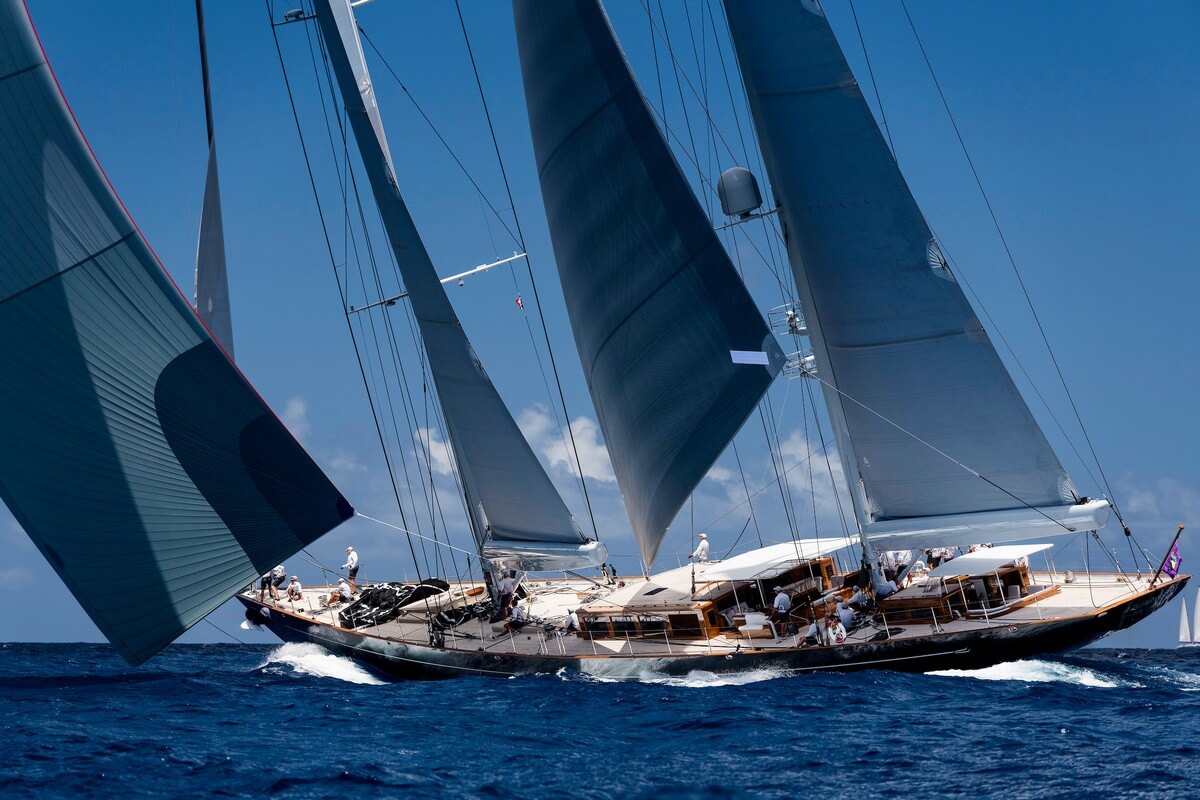
Further Reading
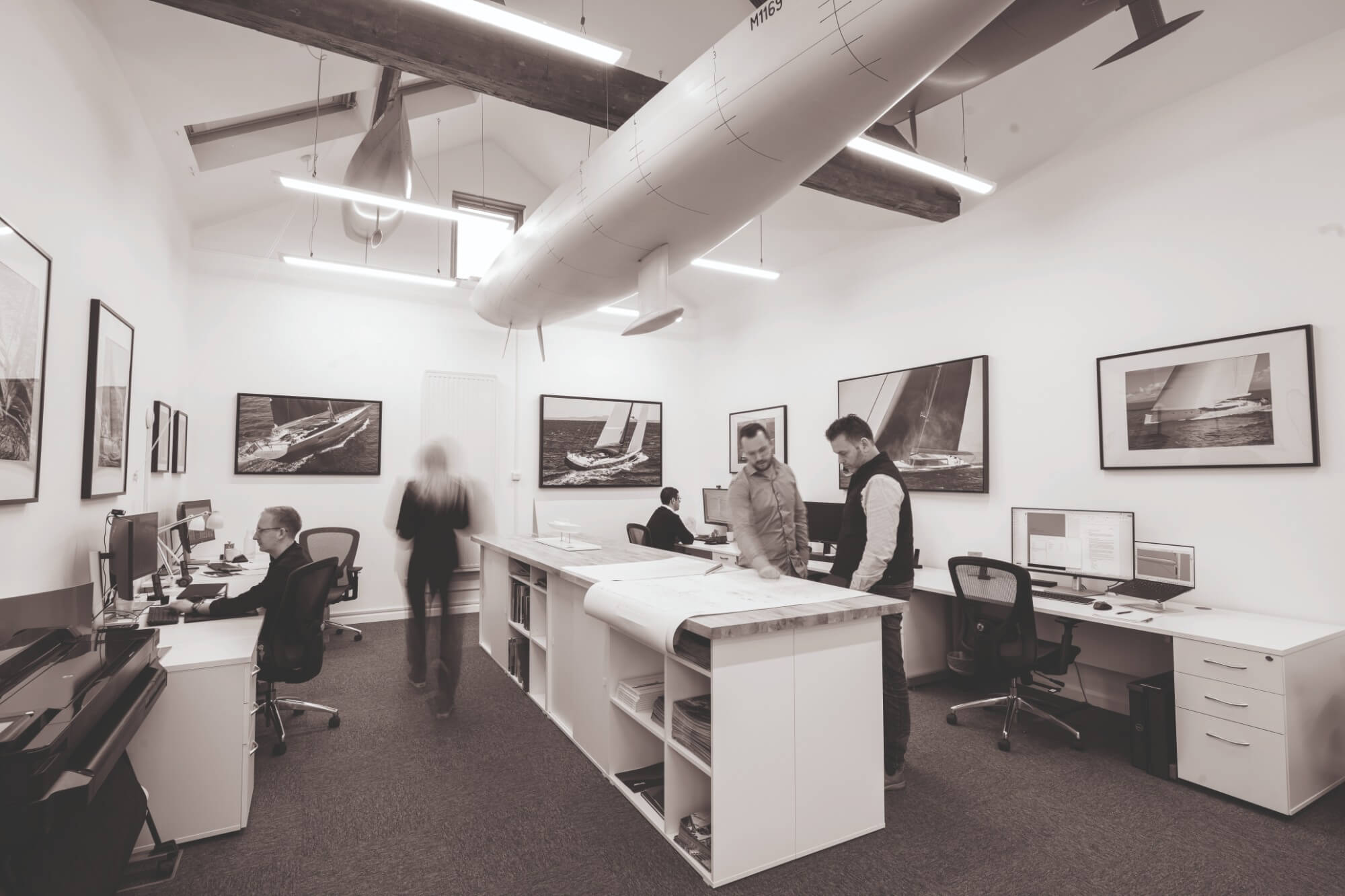
Design I number 08
The view from here.
Having spent his younger years messing about in dinghies, self-taught sailor and world-class designer Malcolm McKeon knows a thing or two about sailing yachts. Here, the award-winning naval architect shares some personal insights on his four decades in the industry, as well as his ideas for the future
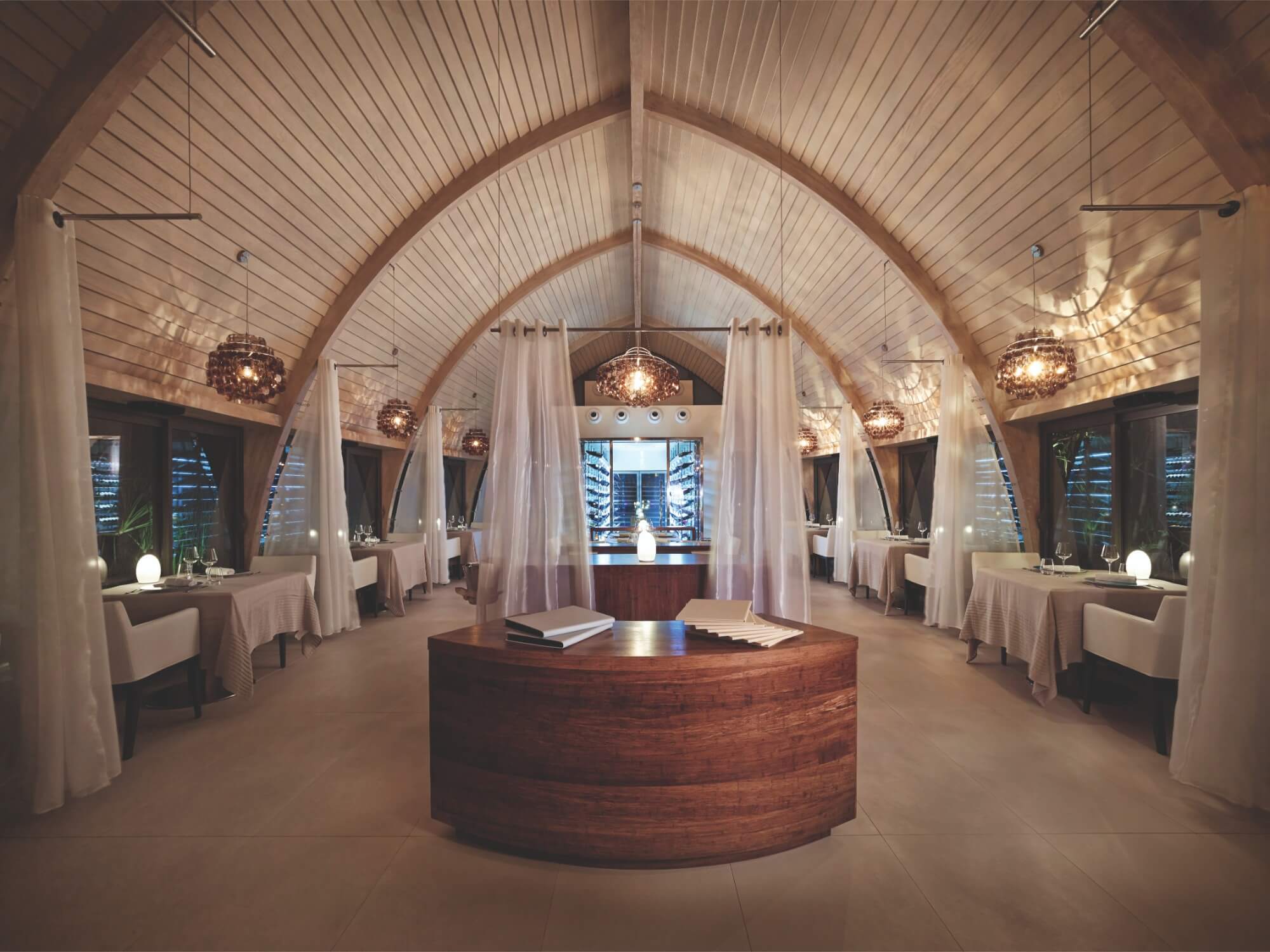
Travel I number 08
The high low: french polynesia.
French Polynesia brings to mind ambrosia; lush days spent lounging on chalk-fine sand, crystalline waters lapping gently along the shore. But there’s more to this archipelago nation than palm trees and beaches, and one way to get to know her is through her rich food heritage
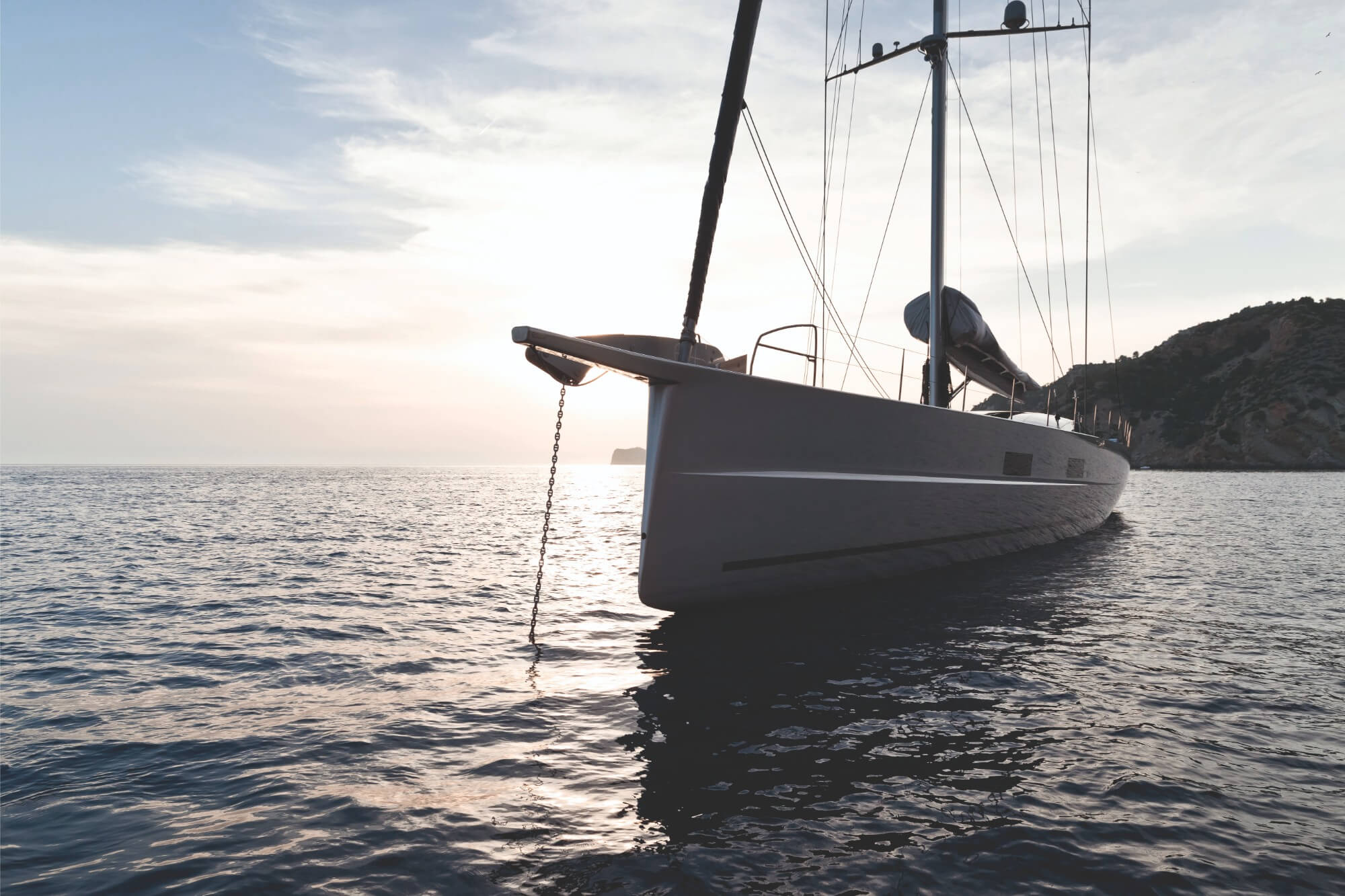
Sailing I number 08
Ribelle with a cause.
Even at seven years old, this 33m lightweight Superyacht remains a masterclass in boat-craft. Here, her Skipper and creator share what makes – and keeps – her a cut above

76' Modern Ketch Iltchi
LOA 23.4 m LWL 20.4 m Beam 6.15 m Draft 2.6 m Yard Aluboot Year 2020

- Ketch sailboats: Sailing's timeless treasures
Ketch sailboats have left an indelible mark on the world of sailing, known for their distinctive rigging, versatility, and timeless appeal. In this article, we'll delve into the world of ketch sailboats, exploring their history, anatomy, advantages, and why they continue to capture the hearts of sailors around the globe.
The rich history of ketch sailboats
Ketches have a storied history dating back centuries. Their origins can be traced to the fishing boats of the North Atlantic, where the need for efficient sail handling and stability gave rise to this unique rigging configuration. Ketches later found their place in various maritime endeavors, from fishing to trade and exploration.
Anatomy of a ketch rig
One of the defining features of a ketch sailboat is its two-masted rigging, which typically consists of a taller mainmast at the front and a shorter mizzenmast towards the rear. This configuration allows for greater flexibility in sail handling. Sailors appreciate the ability to balance the sails, making ketches well-suited for both leisurely cruising and long-distance voyages.
Read our top notch articles on topics such as sailing, sailing tips and destinations in our Magazine .
Ketch sailboat
Check out our latest sailing content:
Advantages of sailing a ketch .
Ketch sailboats offer several advantages that continue to attract sailors:
- Enhanced stability: The positioning of the mizzenmast contributes to improved stability, reducing the likelihood of rolling in heavy seas.
- Efficient sail handling: Ketches allow for smaller, more manageable sails, making them easier to handle, especially for smaller crews or solo sailors.
- Versatile performance: Ketches perform well across a range of wind conditions, allowing sailors to adapt to changing weather on extended voyages.
- Balanced sailing: The two-masted configuration enables sailors to balance the sails for optimal performance, reducing the strain on the vessel and crew.
Setting sail on a ketch
Sailing a ketch involves mastering various techniques to harness the full potential of this rigging. Sailors must become proficient in trimming sails, adjusting the mizzen for balance, and handling different points of sail effectively. The art of sailing a ketch is a rewarding journey, offering both challenges and moments of pure serenity on the open water.
The enduring allure of ketch sailboats
While modern sailing vessels have introduced innovative designs and rigging configurations, ketch sailboats maintain their enduring allure. Whether you're drawn to their classic aesthetics, practicality, or the sense of tradition they evoke, ketches continue to have a special place in the hearts of sailors worldwide.
In conclusion, ketch sailboats are more than just vessels; they are a testament to the rich maritime history and the spirit of adventure that drives sailors to explore the world's oceans. Their timeless appeal, versatile performance, and unique rigging make them a cherished choice for those who seek both the thrill and tranquility of the open sea. Whether you're an experienced sailor or new to the world of sailing, a journey aboard a ketch sailboat promises unforgettable experiences and the opportunity to connect with centuries of seafaring heritage.
So what are you waiting for? Take a look at our range of charter boats and head to some of our favourite sailing destinations.
I am ready to help you with booking a boat for your dream vacation. Contact me.

Denisa Kliner Nguyenová

- News & Views
- Boats & Gear
- Lunacy Report
- Techniques & Tactics
CRUISING SAILBOAT RIGS: Ketches, Yawls, and Schooners
I like to use the term “split rig” to refer to any sailplan on a boat where sail area is divided between two (or more) masts, rather than crowded all on to one mast, as with a sloop or cutter. On ketches and yawls, as I’m sure you know, the taller mainmast is forward and the shorter mizzenmast is aft. What distinguishes a yawl from a ketch is more a matter of debate, but I’m firmly in the camp that believes that a yawl has her mizzenmast abaft her rudder. Mizzens on yawls also tend be rather short. On a ketch the mizzen is forward of the rudder and is usually significantly taller. In a classic schooner rig, the taller mainmast is aft and the shorter foremast is forward. On some schooners, however, the masts may be the same height.
For many years it was axiomatic that a split rig must be best for a cruising boat, as it divides the sail plan into smaller, more easily managed components. This was certainly true on older, more traditional boats in the days before modern winches, most particularly on gaff-rigged boats, where the added weight of a heavy gaff and the extra peak halyard made hoisting sails that much harder. For some reason, however, this conceit survived much longer than it should have. As late as the 1970s, and even into the early 1980s, many believed a ketch rig was best for cruising and such rigs were sometimes seen on boats as small as 30 feet. As late as the early 1990s, ketch rigs were also favored on large maxi ocean racers.
Peter Blake’s Steinlager 2 , which won the Whitbread Race in 1990
These days split rigs are much less popular, particularly on boats less than about 50 feet in length, for a number of reasons. First, any rig with two masts is heavier, more complex, and more expensive to create and maintain. Second, split rigs are generally not as closewinded as sloop rigs, primarily because turbulent “dirty” air flowing off the back of the forward sail decreases the efficiency of the aft sail. Third, innovations such as self-tailing winches, power winches, and roller-furling gear have made handling large sails in a sloop rig much easier. Fourth, modern hull and deck designs tend not to favor mizzenmasts. Rudders are now usually positioned right aft, so it is not possible to put the mizzen behind the helm, as on a yawl, and many boat buyers now favor open cockpit spaces and don’t like having a mizzenmast just forward of the helm, as on most ketches.
Split rigs do, however, have some important advantages and still have a few adherents. Ketches are certainly the most popular. A ketch sails very well on a reach, as at this wind angle it is possible to spread maximum canvas on both masts. A key strength here is the mizzen staysail, a loose-luffed midship reaching sail hoisted on the mizzenmast, tacked down somewhere just abaft the mainmast, and sheeted to the leeward rail aft or to the end of the mizzenboom. A mizzen staysail adds a lot of power to a rig and is a great cruising sail. You can usually launch and recover it right from the cockpit and can sometimes fly it with the wind a bit forward of the beam. Large ketches also sometimes fly full mizzen spinnakers, which add loads of power to a sailplan. The masts in this case need some distance between them, which also improves windward performance since the mizzensail then flies in cleaner air.
A cruising ketch flying a mizzen staysail. These of course can also be flown on yawls
Steve Dashew’s 78-foot ketch Beowulf , a large modern cruising ketch designed to be handled by a couple. Note the separation between the masts. Steve often flew an asymmetric mizzen spinnaker when sailing off the wind
Another advantage to having two masts is that if you lose one, you still have another one to keep sailing with. Some conservative bluewater sailors always favor ketches for just this reason. For this to work the rig must not have a triatic stay, which is a length of the standing rigging running between the tops of the masts. A triatic stay supports the mizzenmast in normal circumstances, but brings it down if the mainmast falls, and vice versa. A ketch’s mizzenmast is also a fine place to mount radomes, wind generators, and other paraphernalia favored by cruisers, although a mizzenboom also hampers (though does not prohibit) the use of a self-steering windvane installed on the stern of a boat.
Another example of a modern cruising ketch, drawn by designer Eric Sponberg. Note the triatic stay between the masts
Yawls, meanwhile, are increasingly rare these days. They were very popular for a time under the old CCA racing rule, because the rule didn’t count the extra sail area in a yawl’s mizzensail and mizzen staysail. Designers have pretty much ignored the rig since then, though it is still seen on some older boats and a few small daysailers. Personally, the yawl is my favorite split rig, both because I think it is very attractive, but also because it does have some nice practical advantages.
Profile drawing of an Alberg 37 with a yawl rig. Call me crazy, but I think that’s a really good-looking sailplan!
Most particularly, the mainsail on a yawl is often not any smaller than it would be on a sloop of similar size. Handling the main is therefore not any easier, but there is also no real decrease in windward sailing ability. The mizzen is normally small enough that its receiving foul air from the main is not significant, and the main meanwhile is large enough to drive the boat well on its own. Indeed, you often see yawls beating smartly to weather with their mizzens furled. On most ketches, by comparison, the mizzen is much larger and the main proportionately smaller, so that power is lost driving to windward unless the masts are well separated. On any reach the yawl’s mizzen and mizzen staysail again add power to the rig, though not as much proportionately as on a ketch.
One nice thing about a yawl’s mizzen is that it is far enough aft to really push the stern around. The mizzen can be used, in effect, as an air rudder to balance and even steer a boat while sailing. In close quarters, you can back a yawl’s mizzen at strategic moments to help turn a boat quickly or slow it down. It makes a great riding sail and can be used to keep a boat from sailing around on its anchor or mooring. It is also easy to balance against a headsail, so you can sail a boat in strong winds under “jib and jigger alone,” as the expression goes, with the mainsail furled.
This is my old Alberg 35 yawl Crazy Horse at anchor in the Cape Verdes with her mizzen up to keep her from sailing around on her rode
The third child in this family of rigs, the venerable schooner, is certainly now the most neglected by modern yacht designers. During their heyday in the 19th century schooners were used primarily as cargo and fishing boats and were closewinded compared to square-rigged vessels. By today’s standards, however, they are ungainly on the wind. As we discussed in an earlier post on the history of yacht design , they did briefly dominate ocean racing in the early 20th century, but were soon eclipsed by more closewinded sloops and yawls and are now entirely anachronistic. Their major drawback, aside from poor windward performance, is that their mainsails are often quite large and can be difficult to handle.
A traditional gaff-rigged working schooner under full working sail. That’s a lot of canvas to play with!
Yet the schooner is not extinct and probably never will be. There is an active cult of schooner aficionados who maintain gaff-rigged 19th-century working schooners and early 20th-century schooner yachts as though they were holy relics. Every once in a while, too, a brand-new schooner gets built. Most of these mimic traditional designs, though there are also much more contemporary examples.
An example of a contemporary cruising schooner. Here the mainsail is much reduced in size, which makes it easier to handle. All the other sails–the main staysail between the mast, the forestaysail, and the genoa–are on roller-furlers
Profile drawing of a more traditional schooner rig. This example has a Marconi mainsail, but a gaff-rigged foresail. Note also the fisherman sail hoisted above the foresail
Personally I’ve always believed the best schooner rig is that of a staysail schooner, so named because the working sail flown between the masts is a jib-shaped staysail bent onto a diagonal stay that runs from the foot of the foremast to an elevated spot on the mainmast. Normally this is called the main staysail, assuming there is another forestaysail forward of the foremast. Staysail schooners tend to be a bit more closewinded than straight schooners with foresails on their foremasts, as the main staysail can easily be trimmed to create a nice slot for the mainsail behind it. It’s also very easy to improvise with. As I discovered many years ago when crossing the Atlantic on an old staysail schooner with decrepit sails, it is possible to fly used headsails from other boats as staysails. Also, staysails can easily be fitted with modern roller-furlers.
Staysail schooner sailing to windward with a fisherman up
This staysail schooner is sailing on a broad reach with a gollywobbler hoisted in place of her main staysail. Judging from the huge hole she’s dug in the water, she must be moving at hull speed plus
Schooners of all types are extremely powerful when sailing on a reach since there is so much extra area between the masts in which large quadrilateral midship sails can be flown. The smaller member of this species, the fisherman, is often flown as a working sail and is seen on both regular and staysail schooners. The much larger and more powerful gollywobbler (probably the best name ever for a sail, IMHO) is normally flown only on staysail schooners (which is another reason to favor this version of the rig).
Speaking as an old schooner hand, I can tell you it’s always a very fine day on the water when you can get a gollywobbler flying!
Related Posts

ELVSTROM BLUE WATER RUNNER: Modern Interpretation of Downwind Twin Headsails

CRUISING SAILBOAT RIGS: Converting a Sloop to a Slutter
That’s a nice roundup–and nice pictures! I think even with modern technology ketches deserve a look-in for larger boats. It’s much easier to drop a sail than reef it and a ketch will do very well with just main and mizzen (which most yawls won’t). My former ketch was a pleasure to sail with its big nylon drifter/jib and huge mizzen staysail–the two biggest sails on the boat. No main, no mizzen, no booms to crash about, just two light sails, easy to set and easy to stow.
Leave a Reply Cancel Reply
Save my name, email, and website in this browser for the next time I comment.
Please enable the javascript to submit this form

Recent Posts
- BAYESIAN TRAGEDY: An Evil Revenge Plot or Divine Justice???
- MAINTENANCE & SUCH: July 4 Maine Coast Mini-Cruz
- SAILGP 2024 NEW YORK: Lifestyles of the Rich and Famous
- MAPTATTOO NAV TABLET: Heavy-Duty All-Weather Cockpit Plotter
- DEAD GUY: Bill Butler
Recent Comments
- Gweilo on SWAN 48 SALVAGE ATTEMPT: Matt Rutherford Almost Got Ripped Off! (IMHO)
- Alvermann on The Legend of Plumbelly
- Charles Doane on BAYESIAN TRAGEDY: An Evil Revenge Plot or Divine Justice???
- Nick on BAYESIAN TRAGEDY: An Evil Revenge Plot or Divine Justice???
- jim on BAYESIAN TRAGEDY: An Evil Revenge Plot or Divine Justice???
- August 2024
- January 2024
- December 2023
- November 2023
- October 2023
- September 2023
- August 2023
- February 2023
- January 2023
- December 2022
- November 2022
- September 2022
- August 2022
- February 2022
- January 2022
- December 2021
- November 2021
- October 2021
- September 2021
- February 2021
- January 2021
- December 2020
- November 2020
- October 2020
- September 2020
- August 2020
- February 2020
- January 2020
- December 2019
- November 2019
- October 2019
- September 2019
- August 2019
- January 2019
- December 2018
- November 2018
- October 2018
- September 2018
- August 2018
- February 2018
- January 2018
- December 2017
- November 2017
- October 2017
- September 2017
- August 2017
- February 2017
- January 2017
- December 2016
- November 2016
- October 2016
- September 2016
- August 2016
- February 2016
- January 2016
- December 2015
- November 2015
- October 2015
- September 2015
- August 2015
- February 2015
- January 2015
- December 2014
- November 2014
- October 2014
- September 2014
- August 2014
- February 2014
- January 2014
- December 2013
- November 2013
- October 2013
- September 2013
- August 2013
- February 2013
- January 2013
- December 2012
- November 2012
- October 2012
- September 2012
- August 2012
- February 2012
- January 2012
- December 2011
- November 2011
- October 2011
- September 2011
- August 2011
- February 2011
- January 2011
- December 2010
- November 2010
- October 2010
- September 2010
- August 2010
- February 2010
- January 2010
- December 2009
- October 2009
- Boats & Gear
- News & Views
- Techniques & Tactics
- The Lunacy Report
- Uncategorized
- Unsorted comments

What is a Ketch Sailboat?
Ketch boats are frequently seen in certain regions and offer various advantages in terms of handling. However, what is a ketch and how does it stand out?
A ketch is a sailboat with two masts. The mainmast is shorter than the mast on a sloop, and the mizzenmast aft is shorter than the mainmast.
Ketches are a type of sailing vessel that have been around for centuries. They are known for their unique design, which features two masts – the main mast located towards the front of the vessel and a smaller mizzen mast located towards the back.
Understanding the Definition of a Ketch
Ketch rig is a type of sailboat that has two masts, with the main mast located forward and the smaller mizzen mast positioned aft. The ketch rig offers a variety of sail combinations to be used depending on wind conditions, making it one of the most versatile rigs available. The ketch rig allows for easy handling in all weather conditions, and its balance makes it ideal for long-distance cruising and offshore sailing.
The versatility of the ketch rig lies in its ability to use different sail combinations. For example, when sailing upwind or close-hauled, the mainsail and jib are typically used. When reaching or running downwind, the mizzen sail can be added to increase speed and stability. This flexibility allows sailors to adjust their sails according to changing weather conditions.
The ketch rig also offers excellent balance due to its two-mast configuration. The smaller mizzen mast positioned aft helps balance out the larger main mast located forward, providing increased stability in rough seas. This balance makes it easier for sailors to handle their boats in challenging conditions.
Ketches and Yawls: Understanding the Difference
Mizzen mast position: the main difference.
The primary difference between a ketch and a yawl is the position of the mizzen mast. In a ketch, the mizzen mast is located forward of the rudder post, while in a yawl, it is located aft of the rudder post. This difference in placement has several implications for how each type of sailboat rig handles on the water.
Larger and More Sail Area
Ketches are typically larger than yawls and have more sail area. This extra sail area allows them to generate more power and speed when sailing downwind or reaching. Ketches also tend to be heavier than yawls, which makes them more stable in rough seas. However, this added weight can make them slower to accelerate and maneuver in tight spaces.

Technical Analysis: Comparing Ketch vs Yawl Rigs
When comparing ketch vs yawl rigs from a technical standpoint, there are several factors to consider beyond just their size and sail area. One important consideration is the center of effort, which is the point where all the forces generated by the sails converge. In a ketch rig, the center of effort is typically farther forward than in a yawl rig, which can make it more difficult to balance when sailing upwind.
Another factor to consider is how each type of rig handles in different wind conditions. Ketches tend to perform better in light winds because they have more sail area to catch any available breeze. However, as the wind picks up, their heavier weight and larger size can make them more difficult to handle. Yawls, on the other hand, are better suited for heavy weather because their smaller size and aft-mast position give them better balance and control.
Variations of Ketch Sailboats
Although not frequently seen, the ketch is a type of sailboat that catches one’s attention due to its unique features. They are known for their classic design, spacious interiors, and comfortable cruising capabilities. These boats have been used for centuries as working watercraft, particularly in fishing and cargo transport, due to their ability to carry large loads and navigate in shallow waters. Here are some variations of ketch sailboats that you should know about.
Traditional Ketch Rig
The traditional ketch rig is characterized by having two masts, with the smaller mizzen mast located aft of the main mast. This rig has a triangular mainsail and a quadrilateral mizzen sail. The mainsail is usually larger than the mizzen sail, which provides balance and stability to the boat. This type of rig is commonly found on older sailing vessels.
Schooner-Rigged Ketch
The schooner-rigged ketch features two or more headsails instead of just one like other types of ketches. This rig allows for greater flexibility in adjusting sails according to wind conditions. It also gives the boat more speed when sailing downwind.
Gaff-Rigged Ketch
The gaff-rigged ketch features a gaff rig on both the main and mizzen masts. The sails are typically made of canvas, which gives them a classic look. This type of rig is often found on traditional wooden boats.
The Origin of the Word Ketch
Etymology is a fascinating field that allows us to trace the origins and evolution of words. The word “ketch” is no exception, with its roots dating back to Middle English. In this section, we will delve deeper into the history of the word “ketch” and explore how it came to be associated with a particular type of vessel.
The Middle English Connection
To understand the origin of the word “ketch,” we need to look at its linguistic roots. The word is believed to have originated from the Middle English word “cacchen,” which means “to catch.” This connection makes sense when you consider that ketches were originally designed for fishing purposes.
Samuel Pepys’ Diary
The first recorded use of the word “ketch” was in 1667 in Samuel Pepys’ diary . Pepys described a small two-masted vessel as a “ketch,” providing us with an early example of how the term was used in context. It’s interesting to note that even in Pepys’ time, ketches were already being used for both commercial and recreational purposes.

Ketches: A Historical Overview
17th century origins.
In the 17th century, ketches were developed as a response to the need for more efficient and versatile sailing vessels. The design of ketches allowed them to carry more cargo and sail faster than other types of ships at the time. With their two masts, ketches were able to accommodate a larger sail area while still being easy to handle with a smaller crew.
The early ketch designs were primarily used for fishing and trading, as they could easily navigate shallow waters and enter ports that larger ships could not. Their ability to sail close to the wind made them ideal for coastal trading routes.
Golden Age of Piracy
During the Golden Age of Piracy in the 18th century, ketches became popular among pirates due to their versatility and speed. Pirates would use ketches for raiding other ships, as well as transporting stolen goods back to their hideouts.
One notable example is the infamous pirate Blackbeard’s ship, Queen Anne’s Revenge. This ship was originally built as a French slave ship but was later captured by Blackbeard and converted into a powerful ketch with 40 guns.
Decline in Popularity
As steam-powered ships began to rise in popularity in the 19th century, traditional sailing vessels like ketches began to decline in use. However, they continued to be used for coastal trading and fishing due to their ability to navigate shallow waters and small harbors.
Resurgence in Popularity
In the 20th century, there was a resurgence in popularity among recreational sailors due to their ease of handling and versatility. Ketch designs were modified with modern materials such as fiberglass hulls and aluminum masts which made them easier and cheaper to build. Today, a few modern sailboat designs are based on traditional ketch designs.
Benefits of Ketches
The ketch rig offers several advantages over larger sloops .
- More Balanced Sail Plan One of the main benefits of a ketch is its more balanced sail plan. With two masts, a ketch can distribute its sails more evenly than a sloop, making it easier to handle in rough weather conditions. The smaller mainsail on a ketch also means less heeling (tilting) in strong winds, which can make for a more comfortable ride. The shorter mast height allows ketches to navigate under lower bridges and in shallower waters.costs over time.
- Versatility Ketches offer greater versatility than sloops due to their ability to carry multiple sails with different configurations. This allows sailors to adjust their sail plan based on wind direction and strength, giving them greater control over their boat’s performance. Ketches are also better suited for long-distance cruising as they can carry more gear without sacrificing stability.
- Ease of Handling Ketches have more complex rigging and sail plans than sloops, making them a bit harder to handle. However, despite having an extra mast and rigging, ketches are still pretty easy to manage.
- Reducing Weather Helm with the Mizzen Sail When sailing upwind, weather helm can be an issue that requires constant attention from the helmsman. Weather helm occurs when there is too much pressure on the sails forward of the mast, causing the boat to turn into the wind. The mizzen sail can be used to balance out this pressure by creating an opposing force aft of the mast. This reduces weather helm and makes it easier for the helmsman to steer with less effort.
- Aft Cabins For those who enjoy overnight stays on board, ketches offer more privacy and comfort thanks to their aft cabins. These cabins are located at the back of the boat and provide a quieter space away from the main living areas. They also tend to be larger than forward cabins on other types of sailboats.
What is the purpose of a ketch?
A ketch sailboat is designed to provide better balance and control than other types of sailboats. It has two masts, with the larger main mast located towards the front and a smaller mizzen mast towards the back. This configuration allows for greater sail area and better maneuverability, making it easier to handle in challenging conditions.
Can one person sail a ketch?
It is possible for one person to sail a ketch, but it depends on the size and complexity of the boat. Smaller ketch sailboats can be handled by a single sailor with some experience, but larger vessels will require a crew or advanced sailing skills.
What is the largest sailing ketch in the world?
The largest sailing ketch in the world is currently the 107-meter “Black Pearl,” which was launched in 2018. The Black Pearl is a hybrid sailing yacht that features a combination of sail and diesel-electric propulsion, making it one of the most technologically advanced and luxurious ketches in the world.
What is a 3-masted sailboat called?
A 3-masted sailboat is typically called a schooner if it has two or more fore-and-aft rigged masts, or a barquentine if it has a square-rigged sail on the foremast and fore-and-aft sails on the other masts.
Can you sail a ketch without the Mizzen?
Yes, it is possible to sail a ketch without the mizzen sail, but it may affect the balance and maneuverability of the boat. In general, it is recommended to use all sails on a ketch to achieve the best performance and control. However, in certain conditions, such as high winds, it may be necessary to reduce sail area by taking down the mizzen or other sails.
What are some popular ketch sailboat models?
Some popular ketch sailboat models include the Amel Maramu, the Hallberg-Rassy 43, and the Tayana 37.
Similar Posts

How Much Does Biofouling Slows Down your Boat?
Are you wondering how much biofouling can impact the performance of your sailboat? The amount of how much biofouling slows down a sailboat depends on various factors, such as the type of boat, its size, and the severity of the biofouling. On average, a sailboat with a heavily fouled hull can experience a reduction in…
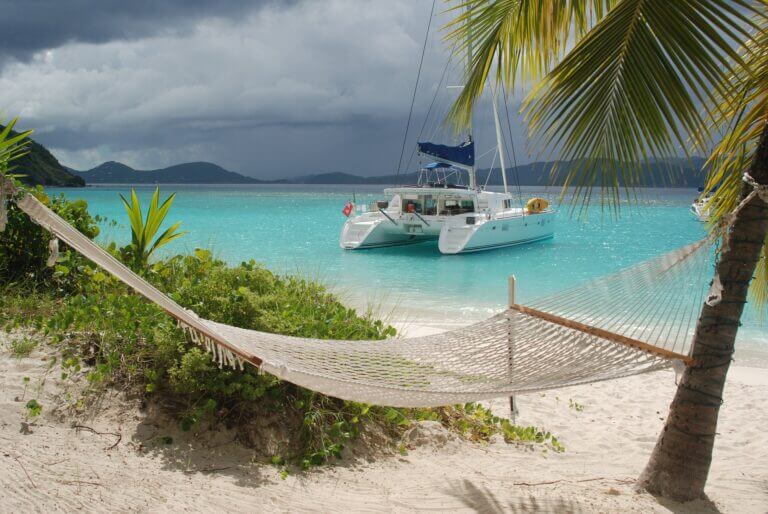
Advantages of Catamaran Sailboat Charter
A catamaran sailboat charter is an exciting way to explore the beauty of the sea. Whether you are an experienced sailor or a first-timer, booking a catamaran sailboat charter has a lot of advantages that you can enjoy. In this article, we will discuss the advantages of booking a catamaran sailboat charter, so that you…
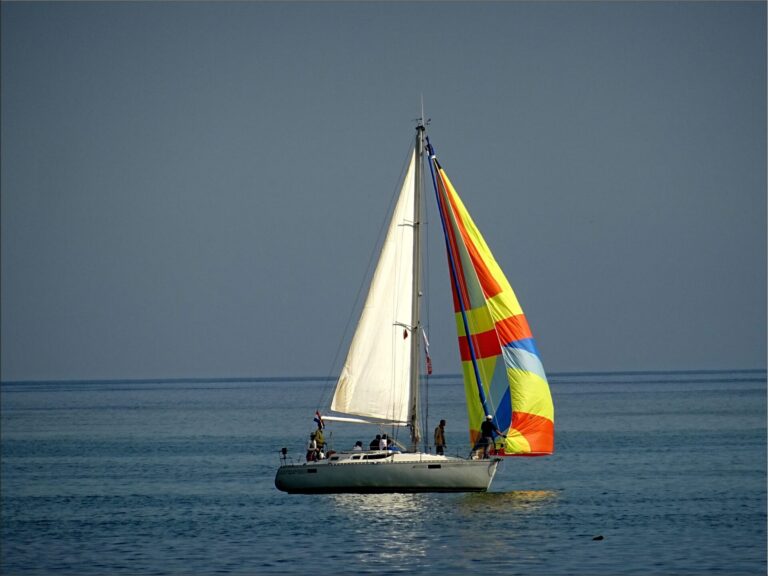
Types of Sails: A Comprehensive Guide
In the enchanting world of sailboat dynamics, where the dance between wind and water takes center stage, the significance of sails cannot be overstated. Like the wings of a bird, these meticulously crafted sails unfurl to catch the slightest whisper of breeze, converting it into a powerful forward thrust that carries us through the vast…

How Does a Marine Toilet Work?
Have you ever wondered how a marine toilet works? If you’re planning to embark on a boating adventure or just curious about the mechanism of a marine toilet, this article is for you. Marine toilets work similarly to the ones on land with a bowl, a seat, and a flushing mechanism that uses water. However,…
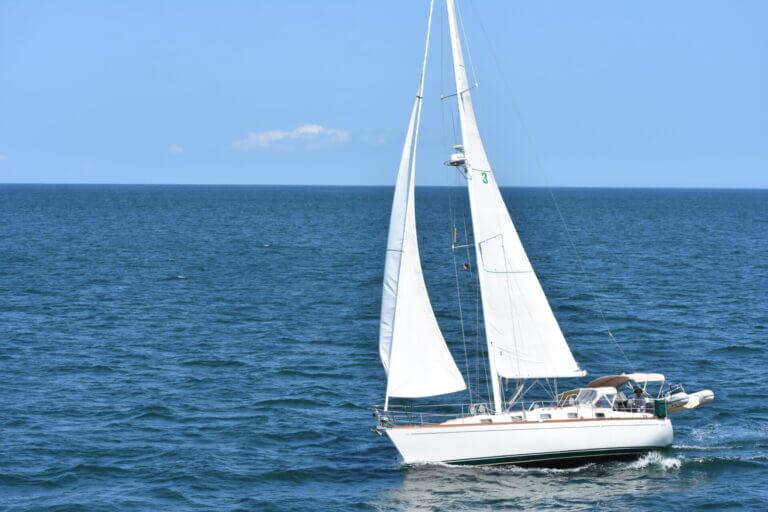
What is a Sloop? Definition, Types and History
A sloop is a type of sailboat that has a single mast and a fore-and-aft rig. Sloops are a type of sailboat that has been around for centuries. They are known for their versatility and ease of handling, making them popular among sailors of all skill levels. Sloops have a single mast and a fore-and-aft…

What is a Keel?: The Backbone of a Ship
As ships sail through tumultuous seas, their stability and maneuverability are tested to the fullest extent. The intricate design and engineering that go into a ship’s construction ensure that it can withstand the forces of nature and navigate through any challenging conditions. One of the most critical components of a ship’s design is the keel,…
- New Sailboats
- Sailboats 21-30ft
- Sailboats 31-35ft
- Sailboats 36-40ft
- Sailboats Over 40ft
- Sailboats Under 21feet
- used_sailboats
- Apps and Computer Programs
- Communications
- Fishfinders
- Handheld Electronics
- Plotters MFDS Rradar
- Wind, Speed & Depth Instruments
- Anchoring Mooring
- Running Rigging
- Sails Canvas
- Standing Rigging
- Diesel Engines
- Off Grid Energy
- Cleaning Waxing
- DIY Projects
- Repair, Tools & Materials
- Spare Parts
- Tools & Gadgets
- Cabin Comfort
- Ventilation
- Footwear Apparel
- Foul Weather Gear
- Mailport & PS Advisor
- Inside Practical Sailor Blog
- Activate My Web Access
- Reset Password
- Customer Service

- Free Newsletter

Blue Jacket 40 Used Boat Review

Catalina 270 vs. The Beneteau First 265 Used Boat Match-Up

Ericson 41 Used Boat Review

Mason 33 Used Boat Review

How to Create a Bullet-Proof VHF/SSB Backup

Tips From A First “Sail” on the ICW

Tillerpilot Tips and Safety Cautions

Best Crimpers and Strippers for Fixing Marine Electrical Connectors

Polyester vs. Nylon Rode

Getting the Most Out of Older Sails

How (Not) to Tie Your Boat to a Dock

Stopping Mainsheet Twist

Fuel Lift Pump: Easy DIY Diesel Fuel System Diagnostic and Repair

Ensuring Safe Shorepower

Sinking? Check Your Stuffing Box


What Do You Do With Old Fiberglass Boats?

Boat Repairs for the Technically Illiterate

Boat Maintenance for the Technically Illiterate

Whats the Best Way to Restore Clear Plastic Windows?

Stopping Holding-tank Odors

Giving Bugs the Big Goodbye

Galley Gadgets for the Cruising Sailor

The Rain Catcher’s Guide

Sailing Gear for Kids

What’s the Best Sunscreen?

UV Clothing: Is It Worth the Hype?

Preparing Yourself for Solo Sailing

R. Tucker Thompson Tall Ship Youth Voyage

On Watch: This 60-Year-Old Hinckley Pilot 35 is Also a Working…

On Watch: America’s Cup

On Watch: All Eyes on Europe Sail Racing

Dear Readers
- Inside Practical Sailor
A One-sided Defense of the Cruising Ketch
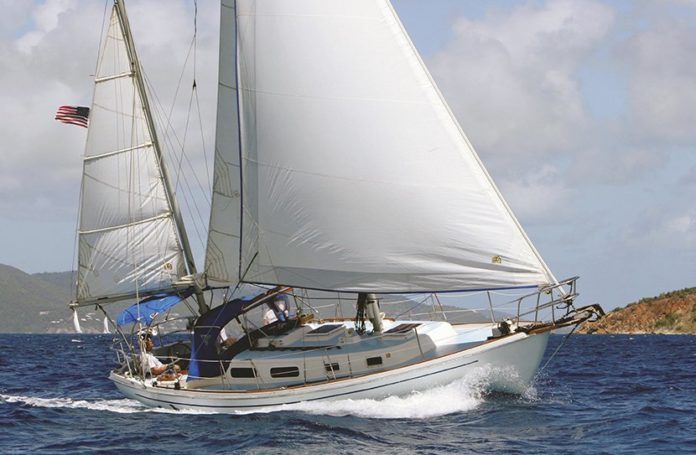
This week I had the opportunity to poke around a ketch-rigged Pearson 424 that was for sale in the neighborhood, and although they’ve generally fallen out of favor today, I was reminded of the many advantages of the ketch design. The Pearson 424 is an example of several decades-old production boats that were offered in a variety of rigs (sloop, cutter, or ketch), which has given longtime owners an opportunity to compare sail plans.
Judging from Pearson 424 list prices and bulletin board discussions about the Pearson 424, it appears that the scales are slightly tilted in favor of the sloop and cutter versions. However, the ketch owners are equally emphatic regarding their boats’ positive attributes. Having covered most of my cruising miles aboard a ketch, I’m an impartial party in this debate. So keep in mind, that much of what you read below (redacted from an earlier post of mine) is colored by personal experience.
My affinity for cruising ketches like the Allied Seawind II we feature in the January 2016 issue of Practical Sailor runs contrary to the view of their many detractors. Their criticism goes something like this: Ketches were popular in early days of cruising when undersized winches and friction-bound hardware conspired to make handling large sails a chore. With efficient winches and modern hardware, split rigs are obsolete on boats under 50 feet, they say.
Having wrestled down the main on more than a few 40-footers with state of-the-art everything, I don’t buy this argument, but I’ll let it stand. Nor will I quibble over complaints about a ketchs handicap to windward-which in my view is overstated, at least with regards to the better designs. Being the first boat to reach a windward watering hole is nice, but it’s hardly the first feature you look for in a good cruising boat.
You can explore the cruising blogosphere and find plenty of resident ketch-haters, and indeed, some of the complaints have merit; the added weight and expense of the ketchs extra rigging are irrefutable knocks. But having lived aboard and sailed a much-beloved, 32-foot William Atkin ketch for 10 years, I’m not interested in joining the chorus. Instead, I celebrate the rigs attractions, especially to the short-handed cruiser.
- Smaller sails are easier to handle. In squally weather, start with a reef tucked in the main, then just furl the mizzen or jib as needed without leaving the cockpit, upsetting helm, or wrestling more reefs into the main.
- Ride the invisible rail. The fore-and-aft distribution of sails simplifies the task of achieving a rock-steady helm.
- Impress your sloop-sailing friends with fancy ketch tricks. Sail backward through the mooring field (spin circles if you have a sharpie), nose casually up to anchor, hove-to with jig and jigger.
- Barrel westward on a reach. Turbo-charge off-wind sailing by setting a mizzen staysail.
- Don’t fear a dismasting. Having two independently stayed masts increases your odds of having at least one spar to use for jury rigging. (This advantage does not apply to ketches with triatic stays like the lovely Sea Witch.)
- Sail in good company. Some famous ketches to consider: Steinlager 2 (1990 Whitbread winner), Suhaili (Robin Knox Johnstons Golden Globe race winner), Joshua (Bernard Moitessiers beloved, steel globe-trotter), Wanderer IV (Eric and Susan Hiscocks storied cruiser), Colin Archers heroic little rescue boats . . . the list goes on.
- Draw longing sighs from those ashore. There is something about having a main and mizzen working together that kindles romantic visions of South Sea islands.
Another nice thing about ketches is that many have reached an age when they are true bargains. Here are just a few familiar ketches worth considering: L. Francis Herreshoffs classic H-28, Gary Hoyts unstayed Freedom 40, Charlie Morgans family-friendly Bahama-mama Out Island 41, Ted Brewers Whitby 42 (aka Brewer 12.8), the Cheoy Lee Offshore 41, any of William Gardens iconic ketches, the Swedish-built Hallberg-Rassy 42, Atkins Ingrid 38 (and her related offspring), John Hannas iconic Tahiti ketch, Holman & Pyes Bowman 57, and two S&S designs, the Swan 57 and Tartan TOCK.
These are just a few that come to mind. I’m sure PS readers have many other boats to add to the list as evidence that reports on the death of the cruising ketch have been greatly exaggerated.
RELATED ARTICLES MORE FROM AUTHOR
On watch: this 60-year-old hinckley pilot 35 is also a working girl, leave a reply cancel reply.
Log in to leave a comment
Latest Videos

Top 3 Winter Boat HACKS!

Cabo Rico 34 Boat Review

Super Shallow Draft Sailboat: The Leeboard Sharpie

Hans Christian 41T – Boat Review
Latest sailboat review.

- Privacy Policy
- Do Not Sell My Personal Information
- Online Account Activation
- Privacy Manager
- Types of Sailboats
- Parts of a Sailboat
- Cruising Boats
- Small Sailboats
- Design Basics
- Sailboats under 30'
- Sailboats 30'-35
- Sailboats 35'-40'
- Sailboats 40'-45'
- Sailboats 45'-50'
- Sailboats 50'-55'
- Sailboats over 55'
- Masts & Spars
- Knots, Bends & Hitches
- The 12v Energy Equation
- Electronics & Instrumentation
- Build Your Own Boat
- Buying a Used Boat
- Choosing Accessories
- Living on a Boat
- Cruising Offshore
- Sailing in the Caribbean
- Anchoring Skills
- Sailing Authors & Their Writings
- Mary's Journal
- Nautical Terms
- Cruising Sailboats for Sale
- List your Boat for Sale Here!
- Used Sailing Equipment for Sale
- Sell Your Unwanted Gear
- Sailing eBooks: Download them here!
- Your Sailboats
- Your Sailing Stories
- Your Fishing Stories
- Advertising
- What's New?
- Chartering a Sailboat
- Cat Ketch Sailboats
Do The Unstayed Rigs Of Cat Ketch Sailboats Really Work?
Cat ketch sailboats are instantly recognizable by their tapered masts and total absence of standing rigging. There's nothing new about free-standing rigs though; they've been around for thousands of years - the Chinese Junk being the best known example.
But we have Gary Hoyt to thank for developing these sailboats for modern day cruising boats.
Hoyt, a former Finn Olympian and Sunfish World Champion, recognised that free-standing rigs would be just as successful on cruising sailboats as they were on his racing dinghies, and set out to prove it.
1977 saw the launch of Hoyt's Freedom 40 cat ketch, of which more than 90 have been produced to date.
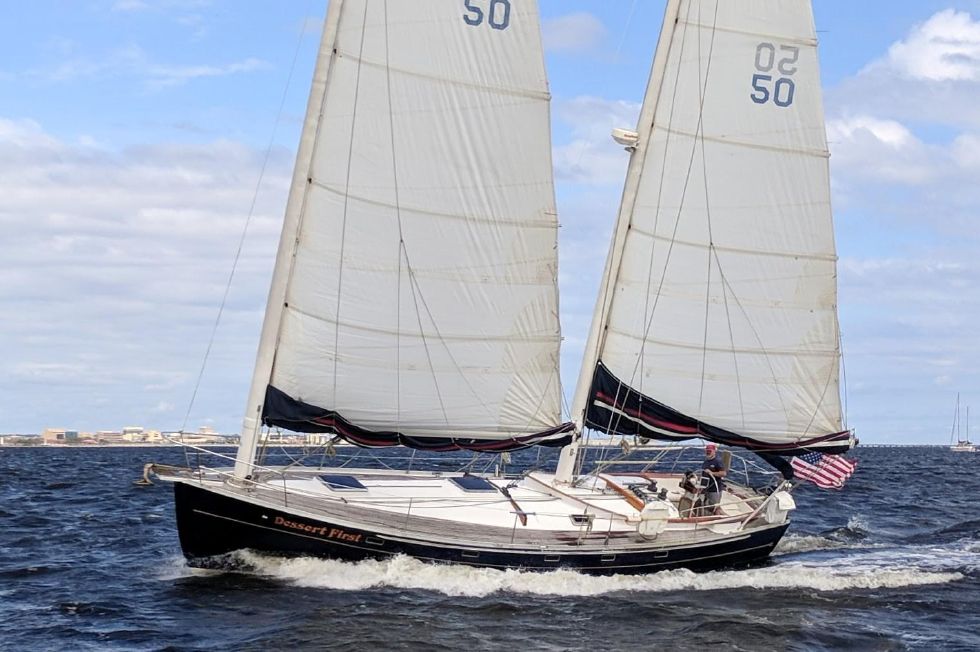
Hoyt's early version had aluminium masts, but the development of carbon fibre spars combining strength, stiffness and light weight enabled these sailboat designs to be brought really up to date.
All unstayed masts are keel-stepped as they rely entirely on the cantilever thus provided by the deck for support. The mast is subjected to bending moment only, with none of the compressive forces that a stayed mast has to withstand.
The flexibility of the rig means that it's impossible to get sufficient forestay tension to support a conventional jib, so any such sail is likely to be a blade type set up on a fractionally rigged forestay. More often than not headsails are dispensed with altogether and a single-masted cat rig or ketch rig used - the Freedom 40 being a notable example.
Either conventional booms or wishbone rigs are used to support the clew of the sail. The wishbone rig greatly reduces the risk of head injury from an accidental gybe - a valuable safety feature indeed on cruising sailboats of any kind. Aerodynamically this rig is very clean - few yachtsmen will lament the loss of the rigging-induced whining when it starts to blow, but it does mean there's less to grab hold of when up on deck.
Advantages of Unstayed Rigs on Cat Ketch Sailboats
- Absence of shrouds and stays means less weight aloft;
- Low centre of effort produces less heeling moment than a conventional rig;
- Flexible unstayed mast bends in strong gusts, flattening sail and de-powering it;
- Ease of tacking and jibing - just change course and the sail will flop over onto the other side of the boat without any drama;
- Running downwind is similarly stress free, with one sail out to port and the other to starboard. If the wind pipes up both sails can be eased forward, spilling the wind and steadying the boat.
Disadvantages?
It's often said that they're less efficient to windward than the Marconi Rig (the Bermudan Sloop ), but off the wind they make up for it.
However, if you take a look at this this video of a heavily reefed 40 ft cat ketch sailboat overhauling a 48 foot cutter you'll have few doubts about their windward ability!
Cat ketches clearly have a lot going for them!
Seen alongside the complexity of a conventionally rigged sailboat, it's easy to imagine that the unstayed rigs of cat ketch sailboats represent the future for cruising sailboat designs
The Cat Ketch Sailboat: A Few FAQs...
What is a cat ketch sailboat?
A cat ketch sailboat is a sailboat that has two masts, one at the very bow and one further aft, and no jib. The sails are usually triangular and attached to free-standing masts that can bend and de-power in strong winds.
How do you sail a cat ketch sailboat?
Sailing a cat ketch sailboat is similar to sailing any other sailboat, but with some differences. Here are some basic tips:
- To tack, simply turn the boat through the wind and let the sails switch sides. You don't need to touch the sheets or the tiller during the manoeuvre;
- To jibe, turn the boat away from the wind and let the sails switch sides. Be careful not to jibe too fast or too hard, as this can damage the masts or cause excessive rolling;
- To reef, lower the halyard until the desired amount of sail is left, then secure it with a cleat or a knot. You can reef either or both sails depending on the wind strength and direction;
- To trim, adjust the sheets until the sails are set at an angle that gives you maximum speed and comfort. You can also use the wishbone booms to change the angle of attack of the sails.
What are some examples of cat ketch sailboats?
Some examples of cat ketch sailboats are:
- The Freedom 40, designed by Gary Hoyt in 1977, was one of the first modern cat ketch sailboats. It has an aluminium mast forward and a carbon fibre mast aft, and can carry a small jib on a fractional forestay;
- The Herreshoff 31, designed by Halsey Herreshoff in 1979, is a classic cat ketch sailboat. It has wooden masts and wishbone booms, and can carry a spinnaker for downwind sailing;
- The Core Sound 15, designed by Graham Byrnes in 2015, is a small cat ketch sailboat. It has carbon fiber masts and conventional booms, and is suitable for beach sailing and day cruising.
The above answers were drafted by sailboat-cruising.com using GPT-4 (OpenAI’s large-scale language-generation model) as a research assistant to develop source material; to the best of our knowledge, we believe them to be accurate.
Recent Articles
The CSY 44 Mid-Cockpit Sailboat
Sep 15, 24 08:18 AM
Hallberg-Rassy 41 Specs & Key Performance Indicators
Sep 14, 24 03:41 AM
Amel Kirk 36 Sailboat Specs & Key Performance Indicators
Sep 07, 24 03:38 PM
Here's where to:
- Find Used Sailboats for Sale...
- Find Used Sailing Gear for Sale...
- List your Sailboat for Sale...
- List your Used Sailing Gear...
Our eBooks...

A few of our Most Popular Pages...

Copyright © 2024 Dick McClary Sailboat-Cruising.com
- Yachting World
- Digital Edition

Aquarius: Modern classic masterpiece makes for a surprisingly sensible superyacht
- August 27, 2020
Named for the sign of astrological quality, this stunning 186ft world-cruising ketch is the result of serious sailors challenging the best of the best to produce something elegant, fast and seaworthy. Rupert Holmes reports
A demanding brief for Aquarius from experienced sailors has produced a masterpiece from some of the most experienced and talented brains in the superyacht world. Within five months of handover she had already clocked up 11,000 miles.
It’s often tempting to sum up new yachts with a short phrase describing their key characteristics. The brief for Aquarius included that she should be, ‘an elegant, muscular sailing yacht with a classic profile for family enjoyment’. But that barely scratches the surface of the main requirements for this giant ketch.
The owners also wanted a yacht that would combine good seakeeping characteristics with performance, reliability and quality. Essential features included relative simplicity, robustness of systems and a contemporary interpretation of elegant, classic lines, with a clean and uncomplicated appearance.
Aquarius ’s graceful lines and timeless shape belie a rugged world cruiser configured to be self-sufficient for extended periods when voyaging well beyond the popular Med and Caribbean circuits. In addition, the yacht is welcoming for family and friends, while providing sufficient performance to compete in superyacht regattas .
Designed to perform
“The owner loves sailing, so top performance was important,” says Dykstra’s Erik Wassen, who led the design team. “Not to the level of a racing yacht, but having the feeling of sailing well and being responsive like a smaller yacht.” A further stipulation was that the boat should not be experimental. The result is a sensible superyacht interpretation of a performance yacht.
With a whopping 50ft of bow and stern overhangs, there’s far less internal volume than might be expected for a yacht of this length. Also maximum beam is less than one-sixth of the overall length. Even so, any temptation to spoil the lines by raising the black-painted freeboard to provide more space for systems was successfully resisted.
Article continues below…

Sea Eagle II: The inside story of the world’s largest aluminium sailing yacht
Royal Huisman has an enviable track record of producing superlative sailing superyachts, with hundreds of projects completed to date. Yet…

Liara: The Baltic 112 superyacht designed to cruise the world in supreme comfort
Over the past decade we’ve been treated to the rise of the custom built cruiser-racer. Arguably inspired by the success…
Considerable work and talent was therefore needed to fit all the requirements into the slender hull. The design team repeatedly honed the arrangements until everything would fit, including adequate space for crew accommodation and servicing of systems.
A fixed 4.8m draught keel fits with the theme of simplicity, while also freeing up the internal space that a lifting or telescopic keel would otherwise occupy. Wassen says: “If it was for optimum performance, you go to seven, eight, nine, ten metres.” The problem is that quickly stops being practical, so his aim was to: “try to get her in the same sort of harbours as the J Class yachts – you can still enter St Barth’s Bucket , for instance.”
Computational Flow Dynamics (CFD) work informed the final hull shape. “In our first hull design we noticed the centre of effort shifted when going from close-hauled to a beam reach to running,” says Wassen. “By optimising the hull shape in the CFD we could minimise that effect, giving much more equal rudder pressure on different points of sail.”

A sense of scale as the seemingly tiny figures prepare the mizzen staysail
The response and feel of a smaller boat was achieved “through having an ample sail plan – the boat has lots of sail – and giving her lots of stability,” he adds. “We kept her as light as possible, which is always difficult because of the weight of the systems and of the ballast needed to provide stability.”
Aquarius ’s skipper James Turner has been very impressed with the handling so far: “With the correct sail plan Aquarius is a delight on the helm, responsive with weight to the wheel,” he reports. “Contrary to what her length and volume might suggest, she feels lively yet forgiving, almost playful on the wheel.”
A clean and uncluttered deck layout was a key priority, but was rendered more difficult by the lack of bulwarks. The profiles of both deckhouses were kept as low as possible, while individual sails are sheeted to similar points, which concentrates deck gear in discrete locations.

Despite her significant sail area, push-button controls mean Aquarius can be sailed by three
Clustering several different items into a single feature also helped to achieve this goal. For example, the boxes for vents and skylights ahead of the main deckhouse also form the backrests for the cushions when this area is used for sun lounging. In addition they house discrete B&G units that provide headsail and spinnaker trimmers with the key data needed for racing.
Project manager Godfrey Cray was keen to use halyard locks to reduce the number of winches around the mast base – the final arrangement has just two winches here instead of the usual four. Attention to detail extends to the cowl vents that have a protection ring of black composite below the polished stainless steel caps so that there is no chance of lines snagging.
The large mizzen was a feature from the inception of the project and provides a powerful configuration for fast reaching and downwind sailing with the mizzen staysail set. A further advantage of this sail plan is that no compromises were needed to keep air draught below the Panamax limit.

Optimised hull shape and big sail area means Aquarius has the response and feel of a smaller yacht
Doyle Sails New Zealand was involved in the project from an early stage, which gave time to tweak the sail plan and for aerodynamic and finite element analysis work to optimise the deck layout and improve overall load predictions. Aquarius is a fast enough boat for the apparent wind to often be forward of the beam.
A 1,580m2 running asymmetric spinnaker is included in the inventory and is clearly important when racing. However, optimisation of the reaching sails was also a priority to enable Aquarius to realise her enormous potential. In addition to the main and mizzen a 460m2 mizzen staysail and 770m2 Code 0 boost the sail area to an impressive 2,200m2 when reaching.
Rondal performance furling booms are a key means of simplifying sail handling , without compromising performance. They allow control of the foot tension of the sail, while providing a very practical means of reefing and stowing the sails.

“Typically, these systems are getting more and more reliable,” says Wassen. “There are hardly any boats that are not specifying them, except for some that go all the way to more racy slab reefing systems to reduce weight aloft.”
Square-top sails were shunned because of the difficulties of handling the top batten. However, the large roach main and mizzen still require running backstays, which are handled by captive winches. “They take more space and are heavier,” says Wassen, “but the captive winches mean you always have the opportunity to ease the runners under load if you have to make an unexpected tack or gybe.”
The twin wheels are positioned far enough outboard to give good sight lines to the bow and the rig. Key sail controls are also located at each helm station to facilitate easy handling. A drawback to this, though, is that you can’t always see the function you’re adjusting. “It’s something we don’t often do,” says Wassen, “and making it look inconspicuous and classic is difficult.”

The solution was a more modern style console with a lot of controls that are fully concealed by hinged teak covers when not in use. This enables the boat to be sailed with only three people on deck.
Key challenges
While the brief for Aquarius deliberately avoided pushing hard against the boundaries of engineering and materials technology, there were still many challenges to overcome before the owners’ vision and dream could be realised.
In particular, a huge effort was needed to fit the accommodation and systems into the low-volume hull. This involved an iterative process between four parties – naval architect, interior designer, the engineers at Royal Huisman, and the owners – to ensure systems and adequate crew quarters could be accommodated, while leaving enough space for the owner and guest accommodation to meet the brief.

There is plenty of relaxation space split across Aquarius’s three cockpits
Interior designer Mark Whiteley initially presented two concepts – one for a relatively dark panelled interior, the other with mahogany furniture and trim balanced by white wall spaces. After the two had been mocked up at full scale for a section of the boat, the owners chose the lighter option. Whiteley subsequently described his challenge as creating, “a light and contemporary classic feel, rather than a more sombre and historically referenced one”.
While this early decision informed the big picture, he says the finer details needed careful judgement to give the boat its unique feel. The final coat of white paint on the wall panels, for instance, was brushed by hand to provide additional character and interest. He says: “This added to the relaxed informality and chic, understated quality you might associate with a house in the Hamptons.”
The main cockpit is the primary social hub of the boat, so considerable effort was put into refining it. This extended to the folding arrangements for the tables and to the design of the additional fold-away seats that face the main U-shape seating areas.

Mahogany joinery is balanced by white trim
The owner wanted a single floor level in the deckhouse, without a higher level for the seating areas, while retaining a view through the windows when sitting down. The lower edge of the windows therefore needed to be brought down as far as possible, which in turn provides a lot of natural light. The skylights also help to flood the interior with natural light.
Two versions of the magnificent owner’s suite were mocked up full-size to ensure every aspect was optimised to the maximum extent possible. There’s ample natural light from the large oval fan light around the mizzen mast, plus four port lights.
The bed is positioned to give a view towards the stairs to the private aft deckhouse, which opens onto its own cockpit. Attention to detail extends to secure stowage for water carafes and personal items.

Natural light floods into the owner’s suite from large fanlights around masts
Guest accommodation includes two double suites, plus a further flexible cabin that’s primarily configured as a twin. Two extra berths can be provided here to accommodate a larger number of children, via a Pullman on the inboard side and a recessed bed that drops down from the deckhead on the outboard side. A great deal of effort was expended to ensure there is no evidence of these extra beds when the cabin is in its normal mode.
There’s also a fully equipped gym, plus a lower saloon, with a huge cinema screen and top end concealed sound system. Quarters for up to 10 crew are provided in five cabins forward. This area has its own access from the foredeck, while guest areas can also be reached from the galley.
What does Whitely like most about the accommodation? “The relaxed feel and the balance between the classic and the contemporary, it really works. I also like the owner’s suite a lot: it’s a fantastic living space.”

The owner’s suite includes private aft deckhouse
Aquarius is the latest addition to a very distinguished lineage of modern classics produced in the past decade by a collaboration between Dykstra and Royal Huisman, including Kamixitha , Meteor and Pumula .
It’s a stunningly successful partnership that, with Aquarius , has produced another beautiful new superyacht that combines the ultimate in elegance with superlative comfort, style and performance.
Specification
LOA: 56.18m (184ft 4in) LWL: 41.17m (135ft 1in) Beam: 9.51m (31ft 2in) Draught: 4.80m (15ft 9in) Displacement: 264 tonnes Mainsail: 520m2 (5,597ft2) Mizzen: 440m2 (4,736ft2) Blade: 430m2 (4,628ft2) Air draught: 58.50m (192ft 11in) Spars: Rondal carbon with Rondal/Carbo-Link continuous standing rigging
First published in the July 2019 issue of Supersail World.
- Newsletters
- Long Island
- Contact & Address
- Surroundings
Modern Ketch – 100′ Sailing Yacht
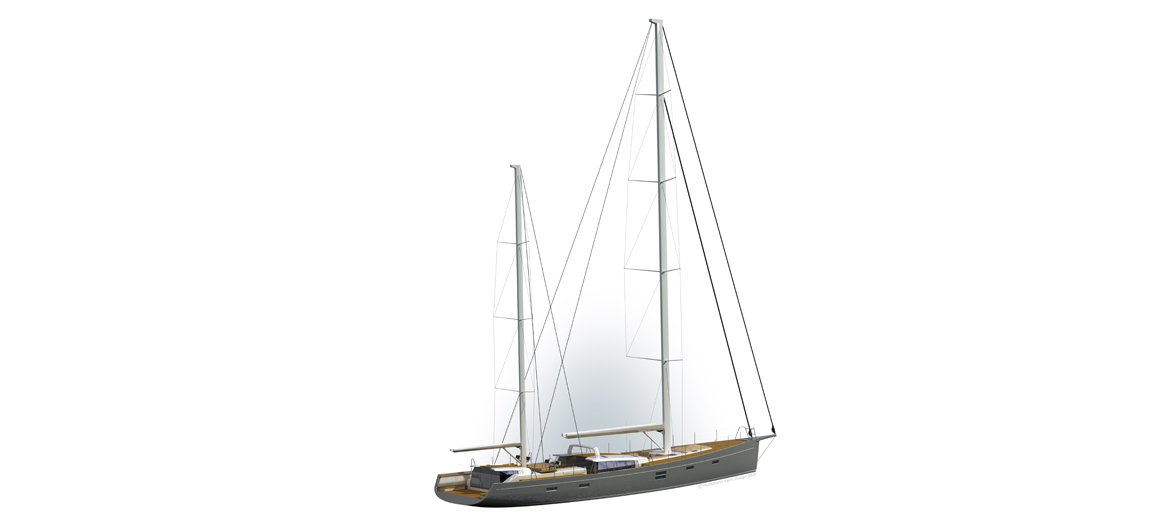
100′ Modern Ketch
This new 100´ Sailing Yacht developed by Rhoades Young Design in partnership with Rob Humphreys Yacht Design is a beautiful performance cruiser with the emphasis on relaxation as well as lifestyle at sea. The 100´ Young/Humphreys superyacht permits the user to be content, comfortable and safe while being able to select from a wide range of relaxation or entertainment areas all available aboard, depending on the mood.
The profile appearance of a contemporary twin deckhouse 100´ Young/Humphreys luxury yacht belies the expanse of accommodation within. A secluded aft beach is accessible directly through glazed doors to the aft cabin within, whilst the sunken cockpit is inviting and sheltered, and maintains a strong and alluring link to the main deck house.
Sporting 360 degree views, enhanced by drop down bulwarks and near full height windows, the deck saloon features an uninterrupted vista from the seating / dining area within. Yet another cockpit nestles forward of the main house for secluded privacy.
With every aspect of life on board considered and revisited, the well developed 100´ yacht is bristling with fresh thinking and approaches to living afloat.
Specifications
| Boat Name | Modern Ketch 100′ |
| Type | Custom sailing yacht |
| Naval Architect | |
| Interior Designer | |
| Material | Glass epoxy infusion composite |
| Length Over All | 30 m |
Other projects
Developed by jfa yachts in collaboration with our naval architects.
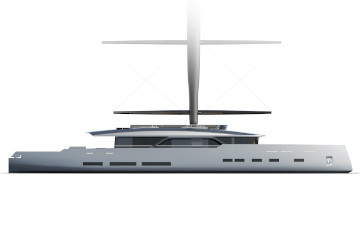

Travel Tips to Kabardino-Balkaria: More than Mt. Elbrus!
If you’ve traveled to the North Caucasus before, there is a good chance you’ve already been to Kabardino-Balkaria, and you didn’t even know it! Kabardino-Balkaria lies in the center of the North Caucasus region, is home to Mt. Elbrus, but more than that is a treasure chest of travel possibilities. Here is our guide to traveling through the republic of Kabardino-Balkaria, or 9 travel tips to this beautiful land:
1. How do I get there?
Kabardino-Balkaria hosts a large number of both foreign and Russian travelers every year, and has an improving infrastructure able to handle the incoming masses. Let’s start with the obvious. You might be a mountain climber or skier coming to enjoy the slopes of Mt. Elbrus. That means you’re likely arriving on an airplane to Russia. Here are your travel options:
A. Plane – We advise you fly into the Mineralni Vodi (MRV) airport in the Stavropol Region, which is about 45 minutes from the border of Kabardino-Balkaria. MRV is the largest airport in the North Caucasus, and has daily direct flights to and from all 3 airpots in Moscow (SVO, DME, and VKO), direct flights from St. Petersburg, and several international flight routes as well, including from Istanbul, Dubai, Greece, Tel Aviv, and Bishkek. The MRV airport has a growing infrastructure and is the most obvious choice to fly into if going to Elbrus. From MRV, it’s a 2 hr. drive to Nalchik, and a 3.5 hr. drive to Mt. Elbrus.
That being said, the capital of Kabardino-Balkaria, Nalchik (NAL), also has a small regional airport with a daily flight to/from Moscow as well as weekly flights to Istanbul. As is to be expected in most smaller, regional airports around Russia, the service standard at a small airport like this will be minimal. As a result, we recommend you flying in and out of MRV if able. It’s a 2 hr. drive to Elbrus from Nalchik. You can also fly into other regional airports which are 2 hrs. from Nalchik, such as OGZ in North Ossetia (Vladikavkaz) or IGT in Ingushetia (Magas).
B. Car/Public Transport – If you have a car, are using a taxi, or are hitch-hiking your way to Kabardino-Balkaria, the region is accessible by a variety of roads and vehicles. A major Russian federal highway E50 runs through Pyatigorsk into Kabardino-Balkaria, and can take you towards Mt. Elbrus, Nalchik, and deeper into the North Caucasus. There are daily mini-buses, or “marshrutkas”, that travel to Nalchik from Pyatigorsk, Vladikavkaz, Grozny, and Magas, if you’re coming from a neighboring republic. From the main Nalchik bus station, there is a marshrutka that goes to Terskol (i.e. Mt. Elbrus) daily around 12:30 pm; for that matter, marshrutkas run daily into every valley of this beautiful republic. For the seasoned international traveler, you can drive from the country of Georgia up the famed “Georgian Military Highway” through the heart of the Caucasus Mountains, cross the border into Russia at the “Verkhni Lars” border stop, and be in Nalchik in about 2.5 hours as well.
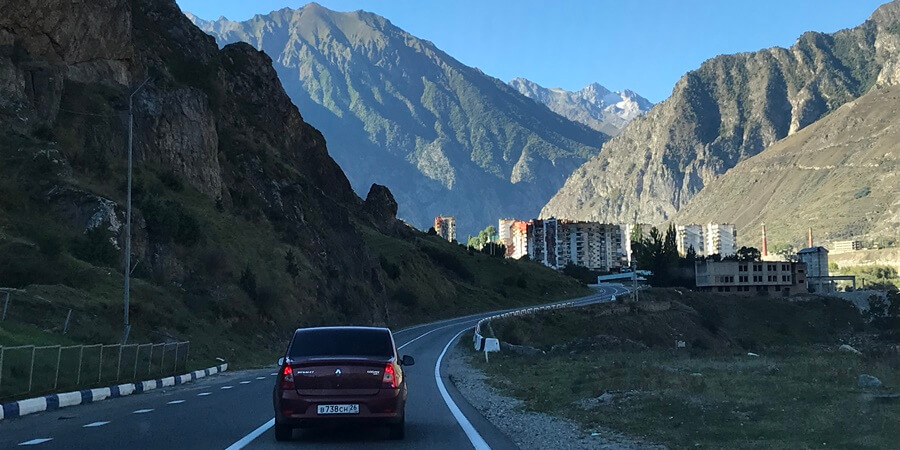
Anyone traveling on their own should download the “Yandex” taxi app, which is Russia’s version of Uber, and has a very user-friendly app with affordable prices. In smaller villages/towns where Yandex’s service doesn’t reach, just ask a local and they’ll direct you to a friend or relative who can taxi you where you need to go!
C. Train – Kabardino-Balkaria is also very accessible by the famous cross-country Russian train system if that’s your preferred method of travel. Almost all trains to the North Caucasus pass through Mineralni Vodi in the Stavropol region to the north, so make sure wherever you are coming from, Mineralni Vodi is one of the stops. Despite Nalchik having a train station, the city is about 45 minutes from the main railway route that runs diagonal through the North Caucasus, and as a result it’s a bit convoluted to get a train directly to Nalchik. That being said, the town Prokhladni is a regular stop on trains going to/coming from Baku, Makhachkala, Grozny, Nazran, and Vladikavkaz, so you can always hop off there and find your way by public transport or taxi.
2. What are the best places to stay?
This list could get exhaustive, fast. 🙂 Let’s first look at an overview of the republic’s geography, followed by hotel recommendations:
A. Nalchik – This is the capital city of Kabardino-Balkaria, with a population of around 250,000. Nalchik is growing and new, modern hotels are being built regularly. Here are some of our recommendations:
-Modern and comfortable: Azimut , Butik Otel
-Budget with less frills: Hotel Rossia , Korona
You could comfortably spend a week in Nalchik, while doing day trips into Kabardino-Balkaria’s beautiful mountain valleys.
B. Baksan Valley – This is the most traveled road in Kabardino-Balkaria, the road to Mt. Elbrus. If you have questions about its safety because of travel warnings, please see our detailed blog here of the drive to erase any doubts or fears. Needless to say, because of the draw of Mt. Elbrus, there are a huge variety of lodging options at the end of this valley, from 4-star to mid-range to budget to hostel. Here are just a few we’ll recommend from our experience:
-Modern and comfortable 4-star-ish: Azau Star , Kristall 139
-Budget with less frills 3-star-ish: Laguna , Povorot
If you’re a mountain climber with your sites set on the summit of Elbrus, you’ll have to spend at least 3-4 nights at Elbrus’s famous base camp at 13,000 feet. The “barrel huts” are not easy to book directly with, and we highly recommend you do your climb (and hence, have your bookings handled) through a trusted climbing company. Here are two shelters at base camp we recommend:
-Modern and comfortable: Leaprus
-Budget with less frills: Heart of Elbrus Lodge
If you’re interested in climbing Mt. Elbrus and staying in these barrel huts, click here to see our climbing itineraries, pricing, and group dates.
C. Chegem Valley – Chegem Valley is the adjacent valley to Elbrus’s Baksan Valley, and is famous for its beautiful waterfalls as well as being Russia’s top paragliding location. The “ Paradrome ” has modest accommodations for those wanting to get to know this beautiful valley for a longer period of time.
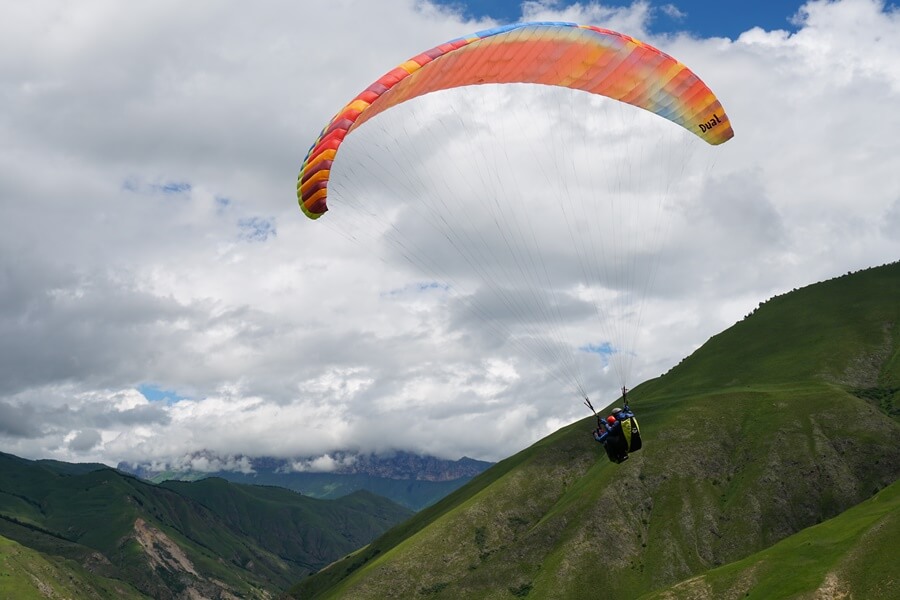
D. Upper Balkaria, or Cherek Valley – This is another beautiful mountain gorge not too far from Nalchik. There is an authentic lodging complex in Upper Balkaria called Tau-El, with amazing local food for meals as well.

E. Border Zone lodging – Several of Kabardino-Balkaria’s mountain gorges run into the border zone with neighboring country Georgia, i.e. an area that foreigners cannot enter without a special permit from the local government (often taking 2 months to receive). There is a famous mountaineering lodge in Bezengi Valley, where several generations of Russian mountain climbers have honed their craft in the Caucasus Mountains. Perpendicular to Baksan Valley (about 25 minutes from the base of Mt. Elbrus) is Adyr-Suu Valley, where there is a lodge for back-country skiers to stay, while trying their hands (and feet!) on the untouched snow of that valley. Both these valleys require border permits for foreigners, but are possible to access for the more adventurous!
3. Top cities to visit?
Most locals would agree that Nalchik is the main city of significance to visit in Kabardino-Balkaria, but let’s be honest, even more would say, “Just go to the mountains!” Tirnauz is the capital of the Elbrus district, and is an interesting town to spend some time in, with its unique location in the mountains and place in Soviet history as a once-booming mining town. The main thing to consider in visiting Nalchik and other cities in the lowlands, is the chance to experience Kabardian culture and food. Whereas the deeper you go into the valleys, the more you’ll encounter Balkar culture and food.
4. Best local foods to try?
There are 3 types of food that come to mind, when spending time in Kabardino-Balkaria:
A. Khychiny – This is one of the staple national dishes of the Balkar people, and what you’ll inevitably be served if guests of local Balkars. It’s a thin buttery flat bread, sometimes cooked with fillings of cottage cheese, fresh greens, or potatoes. It is often slathered in butter, but wow is that some tasty greasy goodness! 🙂

B. Shashlik – Shashlik is a MUST for any visit anywhere in the North Caucasus! Most people would agree that it’s the national food of the entire region. Shashlik is meat shish kabobs; while pork and turkey can be found in some parts of the Caucasus, lamb or chicken are the preferred shashlik meats of choice in Kabardino-Balkaria.
C. Soup – No matter where you are in Russia, you’re sure to find a local soup that people love. Kabardino-Balkaria is no different. Especially in the winter months in the mountain valleys, there’s nothing better than to come inside from the cold weather and warm your body up to a bowl of hearty Caucasus soup. Whether Georgian kharcho or local Balkar lakhman, make sure to try your hand at one of these soups with a side of fresh baked bread/lavash!

5. Top Hole-In-The-Wall restaurants:
Of course, for a republic of this size, we’re bound to leave at least a few great local joints off our list, but here are a few to get you started. ***Note: Restaurants in the North Caucasus are much better known for their food than their service, so prepare for tasty food, but manage your expectations about service:
-Elbrus – Kogutai Restaurant at Mt. Cheget – While this isn’t a hole-in-the-wall restaurant per se, it’s one of many to choose from in the Cheget tourist village, and we have found them to provide consistently good food and service. Kogutai has a nice interior, and maybe most important, an English-language menu with good pictures. 🙂 There also is a nice outdoor patio with fantastic views of the surrounding mountains.
-Nalchik #1 – Tameris Restaurant – This is a cafe with a relaxed atmosphere in the capital Nalchik. Local tour company Elbrus Elevation has taken foreign groups there on multiple occasions and always had good experiences. Address is ul. Kuliyeva 3.
-Nalchik #2 – Cafe-Bar Oasis – You have to know where this restaurant is to find it, but once inside, you won’t regret it! There is a unique cafeteria-style ordering process, that includes several dishes being cooked on the spot once ordered. You can sample local Kabardian dishes here. The seating area is very modern and a pleasant atmosphere to have a meal in. Address is ul. Kuliyeva 2.
-Upper Balkaria – Tau-El Restaurant – This is the restaurant part of the Tau-El Tourist Complex in Upper Balkaria. Whether spending the night or just passing through, make sure to stop here for a meal!
6. Must-See Sites
This republic is so chock full of “must-see” destinations, it’s impossible to narrow the list down. Here are just a few suggestions to get you started: (***Mt. Elbrus is a no-brainer and we’re assuming that’s on your list)
A. El-Tyubu and Paradrome – This is an amazing area towards the end of Chegem Valley. Many tourists visit the famous Chegem Waterfalls and don’t drive any further down this gorge, which really is a shame. El-Tyubu is a picturesque Balkar village with several historical sites to see, including some ancient mausoleums. The real gem of the area, though, is the Paradrome , which is Russia’s premier paragliding destination. The combination of the scenic surrounding mountains and constant winds produces almost daily conditions to sail through the beautiful Caucasus sky. Highly recommend!
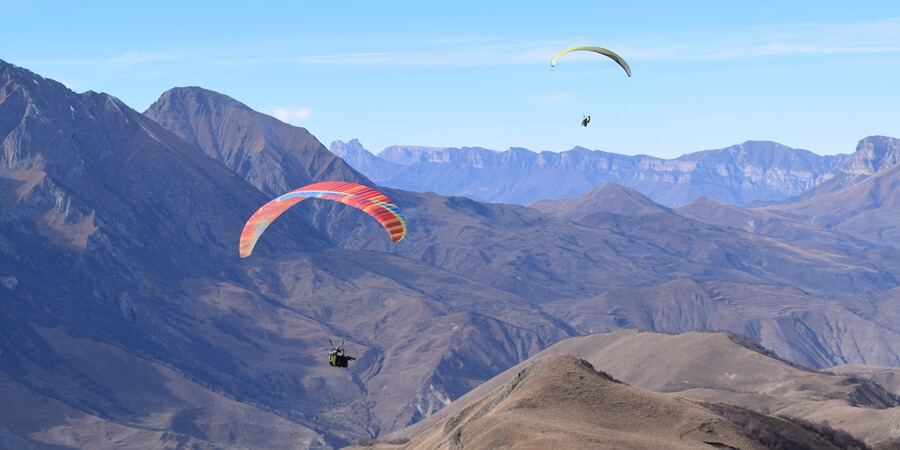
B. Upper Balkaria – Also known as Cherek Valley, the entire drive to the actual village of Upper Balkaria is one big destination. First, you can spend time at the 3 consecutive “ Blue Lakes ”, one of which is one of Russia’s deepest lakes with an underground spring. Then, the drive itself becomes an adventure, as you pass by steep rock walls with a huge drop-off on the other side. If you’re able to walk this part of the road, that is a bonus! Once you’ve made your way through the valley walls, the region opens up into a beautiful panoramic view. Many years ago, there were multiple villages in this region, but they’ve since been condensed into one main village. You can see some of the ancient Balkar towers that their ancestors used to live in as well.
C. Djili-Suu – Although hard to pronounce and not easy to get to, Djili-Suu is one of those places in the North Caucasus that people rave about that you “have to” visit. It’s actually on the North side of Mt. Elbrus, and more accessible from the Mineral Waters region (2 hrs. from Kislovodsk). The base camp for Elbrus climbers summiting the mountain from the North side is at Djili-Suu. This area is famous in Russia for its numerous natural healing springs, as well as unique climate conditions that make for beneficial, long holidays for seeking a respite from their daily grind. There are wide swaths of land available for camping, with probably the most unrivaled views of Mt. Elbrus in the North Caucasus. Make sure to check this out!
7. Off-the-beaten path destinations

A. King’s Waterfalls (Tsarskie), or Gedmisht – Probably the valley in Kabardino-Balkaria with the least amount of hype is the Malka Valley, which is the northernmost valley and mainly runs through the Kabardian lowlands. At the point where the villages end, though (Khabas), the asphalt turns into dirt and the hills start to rise, culminating with the incredible King’s Waterfalls, or as one friend put it, Avatar Waterfalls. These stunning waterfalls are best visited in the early summer, when everything is lush green and the water flow is strong, with many streams of water flowing down the earth’s surface. The different colors are incredible and it’s hard to look away. Once you’ve enjoyed the waterfalls, enjoy a meal of shashlik at one of the nearby lunch huts. Having an off-road vehicle is ideal to visit these falls, but worth the time and effort!
B. One-seater chair lift at Elbrus – As the infrastructure at Mt. Elbrus has modernized, some of the more “authentic” experiences have gone to the way-side. This is one experience still available, though! From the 2nd (11,000 ft.) to 3rd level (12,500 ft.) of Mt. Elbrus (whether skiing, going to base camp, or just touring), there is a single-seater chair lift for 100 rubles each way (less than $2). This is an amazing experience if you have the time. It’s 8-10 minutes each way, and a surreal experience of the majestic Caucasus mountain range surrounding you, skiers silently passing you by underneath, and in general enjoying the silent expanse of nature all around. The chair lifts are from the Soviet times and so it feels like something from a different era. For mountain climbers, the newer group cable car gives better access to most of base camp, but several huts are pretty close to this chair lift, so it still may be a good option for you.
C. Abandoned Mines above Tirnauz – Tirnauz is about 1 hr. from Mt. Elbrus, and a town everyone drives through to and from the mountain. Although today it looks old and half-abandoned, it was a booming mining town in the 20th century. About a 45-minute drive above the city with an off-road vehicle, you can see the remains of the mining operations. Learning about this history combined with the breath-taking views of the Baksan Valley and even into Georgia, you’ll wonder why more people aren’t visiting this place. This is a great spot to see eagles soaring in the sky, as well as admire the Soviet city plan of Tirnauz from above.
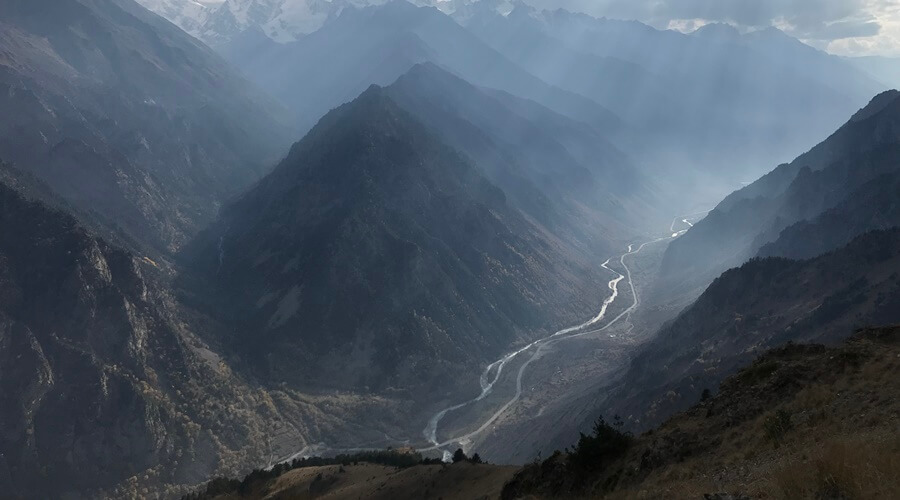
8. What do I need border zone passes to visit?
In Russia, any area within 5-10 km of a neighboring country, without a clearly delineated border (i.e. in the mountains) is considered a special border zone, and patrolled by Russian border guards. This area IS accessible to all Russian citizens with their passports, but is NOT legally accessible to foreign citizens UNLESS you have a special permit from the FSB (Federal Security Bureau). These permits are accessible, either through a tour operator or local friend, but require you to submit your application 45-60 days in advance.
Areas in Kabardino-Balkaria that are worth a visit if you have a border zone pass:
A. Bezengi Wall – This is at the end of the Bezengi Valley, and holds a place of lore among Russian mountain climbers. Many mountain guides go through training in this valley. Five of the Caucasus Mountain’ range’s highest seven peaks are a part of the Bezengi Wall, so you can imagine the draw it has for climbers. There are great areas for trekking and camping in this area.
B. Adyr-Suu Gorge – This remote valley runs perpendicular to Baksan Valley and is about 25 minutes from the base of Mt. Elbrus. It’s marked at the entrance by a relic of the past, a car lift from Soviet days that auto-cranks your car (and you) about 50 meters up the mountain. After 45-60 minutes of driving on gravel road, the gorge opens up into a flat valley with a beautiful view of the surrounding mountains. The Adyr-Suu Alpine Lodge is at the end of this valley and where back-country skiers base out of during the acclimatization phase of their Mt. Elbrus ski tours. This is truly a place where you can experience untouched powder!
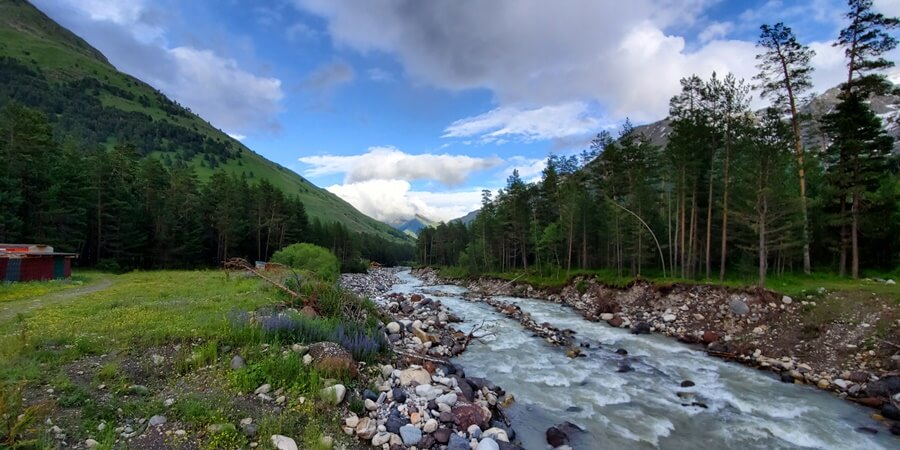
C. Mt. Cheget (Elbrus) – Cheget is a neighboring mountain to Mt. Elbrus and where many climbers will acclimatize, both at its base and while doing some hikes. It also is famous in Russia for its free-ride terrain for more experienced skiers. Standard access to the chair lifts and mountain are available to all (i.e. mountain climbers don’t need to worry about accidentally crossing into the zone), but anyone wanting to summit the peak of Cheget OR visit the beautiful Cheget Lake needs a border permit.

Foreigners violating the border zone areas is considered a serious offense in Russia; make sure to do your due diligence if wanting to visit one of these areas! We highly recommend using a local tour operator and always traveling with a local person if visiting one of these areas.
9. Any cultural “do’s” or “don’t’s” to be aware of

Kabardino-Balkaria is a fascinating republic with a combination of traditional and modern society. The more you interact with local people, the more you’ll see a mixture of Muslim faith, post-Soviet mentality, and ancient local traditions all wrapped together.
Kabardians mainly live in the lowlands (Nalchik, Baksan, and lowland villages), while Balkars primarily live in the mountain valleys (Elbrus, Chegem, Upper Balkaria, etc.). There is a large population of Russians in the region as well. Foreigners visit every area of the region regularly, and so local people are used to and will welcome your presence.
Come with an open mind to learn about these peoples, their traditions, and their land. You won’t regret your trip to Kabardino-Balkaria!

***Want to learn more? Here are several self-published resources from the podcast “ CaucasTalk ” related to Kabardino-Balkaria:
– Travel Tips to Kabardino-Balkaria (audio version of this blog)
– History of Mt. Elbrus (Part 1)
– History of Mt. Elbrus (Part 2)
– Interview with Local Elbrus guide
– Climbing Elbrus: Interview with American guide
– Who are the Kabardians? (Part 1)
– Who are the Kabardians? (Part 2)
– Skiing in the North Caucasus (Elbrus and more)
READY TO EXPERIENCE KABARDINO-BALKARIA FOR YOURSELF?
Where to find us.
- +1 704-810-4296
- [email protected]
- 1578 Pine Creek Rd., Gastonia, NC 28056
Travel Information
- We no longer offer travel services to Russia. See Caucasus Quest Tours for new destinations
- Is it Safe to Travel to the Caucasus in 2024?
- Climbing Kazbek & Kilimanjaro: Comparing two 5,000+ meter peaks
- How to Train to climb Mt. Kazbek in Georgia
Our Elbrus Climbing Tours
- Climb Elbrus South Route
- Climb Elbrus North Route
- Climb Elbrus & The Capitals
- Climb Elbrus & The Caucasus
Russia Cultural Tours
- Capitals of Russia
- Lake Baikal on Ice
- Delightful Dagestan
- Heart of the Caucasus
ALL Travel Services to Russia and Mt. Elbrus have been indefinitely suspended as of Feb. 2022.
Explore our new tour branch Caucasus Quest to climb Mt. Kazbek (5,054 meters) in Georgia or for immersive cultural touring experiences in Georgia, Armenia, and Azerbaijan.
Visiting Russia - Nalchik, Capital of Kabardino-Balkaria
By Koryo Tours
Nalchik, capital of Kabardino-Balkaria
Visiting Russia – Nalchik
Yoshkar-ola | cheboksary | astrakhan | elista | stalingrad (volograd) | abakan | nalchik | validkavkaz | makhachkala | grozny.
Nalchik is a small city of around 240,000 people and serves as the capital of Kabardino-Balkaria, one of the lesser-known republics spread across the beautiful North Caucasus area of Russia, the mountain range that separates the former soviet states of Georgia, Armenia, and Azerbaijan from the Russian Federation.
This region has incredible diversity in ethnic groups and is a melting pot at the edge of empire. While there have been civilisations in the Caucasus for millennia Nalchik as a city is only a century old, having been a Russian fort since 1724. Today’s Nalchik is a mostly peaceful and relaxing place, being in the foothills of the mountains it has many areas of great beauty and multiple sanatoria for people looking to take the waters, over the last century it has certainly had its share of turbulence though, being occupied by Romanian troops fighting on the side of the Nazis, who embarked on an effort to exterminate the ancient community of Mountain Jews in the area (unsuccessfully), plus a 2005 Islamic militant attack on Russian security forces.
These days Nalchik is known as a clean city, a place for relaxing, and the starting point of expeditions to summit Mt. Elbrus, the tallest mountain in Europe, which lies within Kabardino-Balkaria.
Kabardians make up the largest ethnic group at just under 50% of the city’s population, followed by Russians, Balkars, other Caucasian nationalities as well as Ukrainians, Mountain Jews still live in the area but in very small numbers now, most having emigrated to Israel.

Arriving/Departing
Nalchik Airport (NAL) is a small one but is fully functional for getting in and out, usually the foreigners arriving here will be mountaineers heading for Elbrus.
The Airport is only 3km from the city centre so you could even walk into town from here, otherwise, there are taxis and marshrutkas waiting for arrivals. Flights arrive only from Moscow and St. Petersburg usually, the Caucasus has other larger airports for other international flights (such as those to Sochi). Nalchik has a railway station, dating from 1915, with links to Moscow and across the Caucasus. A good option for travelling around the region in a relaxing manner (usually slower than taking a marshrutka between cities though) For getting around inside Nalchik there are public buses all over the place, easy to use and very cheap. Otherwise most of the centre is very walkable, the main ‘high street’ is Lenin Avenue, which runs for several km through the centre of the city.

Concord Square
The centre of Nalchik and a good place to start a walking tour of the city, with the Kabardino-Balkaria parliament building on one side and Lenin stands at the other, fountains in the middle and Lenin Avenue cutting through the square
Religious Buildings
The central buildings of the main religions practised in Nalchik are both fine examples of their respective architectural styles; the Central Mosque and the Cathedral of Mary Magdalene are both worth visiting. Dress codes apply.
Not actually in Nalchik, but only 50km or so away so the city is the ideal base for starting an expedition. This is Europe’s highest mountain and a dormant volcano. There are cable car/chairlift options to get t the top for those who don’t wish to do it the hard way. It is possible to get up and down this mountain n a single day, making it certainly the simplest of the 7 continental highest peaks to climb.
Museum of the Kabardino-Balkar Republic
Great for explaining where you are and the history of the area. Mostly in Russian only though and does tend to assume some knowledge in advance. Still a good stop to get some intro into the complex history of this city and area in general.
Atazhukin Garden
A large park complex running for more than 2km along the eastern side of the city, alongside the Nalchik River. A very pleasant place with so much to see and do. The basic Nalchik Zoo is here, walking trails, restaurants and cafes, theatres, a very retro funfair, and a rickety but reliable cable car running up to a lovely viewpoint to see over the city and out to Mt. Elbrus.
Topped by a restaurant building built in the shape of a Kabardian warrior. An excellent few hours can be spent exploring this park and mingling with the locals of all ages who do their relaxing here.

Koryo Tours Russia Tours
Related articles, what's brewing at taedonggang beer company no. 8 beer.
A first visit to the Taedongang Beer Brewery production floor with Koryo Tours.
The Koryo Guide to North Korea (DPRK)
The world's first (and free!) online guidebook to travel in the DPRK
Museums of Beijing #99: Museum of the Communist Party of China
Epic Party! Epic Museum!
Visiting Russia - Grozny, Capital of Chechnya
Grozny, Capital of Chechnya
Museums of Beijing #34: Guo Moruo Memorial Museum
Museums of Beijing: Guo Moruo Memorial Museum
Human Zoo - the 1907 Colonial Exhibiton
Visiting the relics of a major event
Museums of Beijing #9: Mei Lanfang Memorial
Museums of Beijing: Mei Lanfang Memorial
Museums of Beijing #58: Beijing Quaternary Glacial Vestige Exhibition Hall
Beijing's only Glacier museum!
Museums of Beijing #87: Pingbei Sino-Japanese War Martyrs Memorial Park and Exhibition Hall
Resisting Japan in the north Beijing area
Museums of Beijing #84: Capital Grain Museum
Museum in a former noodle factory
Museums of Beijing #40: Theatre Museum of Beijing People's Art Theatre
Museums of Beijing: Theatre Museum of Beijing People's Art Theatre
Museums of Beijing #81: China Agricultural Museum
In one of the Ten Great Buildings of Beijing!
Hotels of the DPRK: Local Guesthouses
Some accommodations for domestic travelers in the DPRK
Exploring Soviet Mongolia's Past
A Soviet Mongolia? Mongolia is steeped in communist history, from abandoned military bases to hidden statues of Lenin!
Museums of Beijing #47: Mao Zedong Memorial (Mausoleum)
Mausoleum of Chairman Mao
You have successfully joined our subscriber list.
- Group Tours
- Private Tours
- Pyongyang Marathon
- Turkmenistan
- Cultural Engagement
- Country profile
- Terms & conditions
- Why choose Koryo
[email protected] | + 86 10 6416 7544 WhatsApp (message only): +44 7822 014058 Room A409, Jucai Building. No. 76 Caoyuan Hutong. Dongcheng District, Beijing, 100027, PR China
中国北京市东城区草园胡同76号聚才大厦A 座409 室, 邮编:100027 Download contact card
Not registered yet? Register now
Trouble logging in? Reset password
* All fields are mandatory
Got an account already? Let me log in

IMAGES
VIDEO
COMMENTS
Ketch sailing vessels pricing. Ketch sailing vessels for sale on YachtWorld are listed for a variety of prices from $12,360 on the relatively lower-priced, classic models all the way up to $15,668,478 for the more lavish boat models. Find Ketch boats for sale in your area & across the world on YachtWorld. Offering the best selection of boats to ...
For most of the 20th century a ketch rig was a mark of a serious large sailing yacht (see our full article on sailing boats and their rigs) and the envy of many owners of smaller sloop rigged vessels.A key attraction was that splitting the sail plan into smaller units made a lot of sense on boats over 35ft in the days before modern efficient and sophisticated sail handling systems It's easy ...
It offers more versatility in sail plan, and is known to handle very well in heavy winds. The ketch rig is an especially effective rig for larger boats (40ft and up). Just a quick recap: the ketch is a two-masted sailboat that has a mainmast (front) and shorter mizzenmast (aft or back). Both masts carry a mainsail.
Sailing I The Modern Ocean Ketch WORDS: Jack Gifford | PHOTOS: Cory Silken & Breed Media. The heritage of the modern ocean ketch comprises many of the world's most iconic yachts and, whilst the latest creations are larger, faster and more technologically advanced, they continue to prove why the twin rig concept ticks all the boxes.
76' Modern Ketch Iltchi. Modern living on the same level with a combined decksaloon and galley plus an easily-managed sailplan were two of the prerequisites for this long distance, fast cruising yacht. The client chose a more contemporary look for this 23m ketch with an attractive bow shape and built-in ...
The maximum number of passengers for ketch sailing vessels currently listed on Boat Trader is 14 people, with an average capacity of 11 people. The most viewed brands for ketch sailing vessels this month were Allied, Custom, Formosa, Morgan and Nauticat. With 83 ketch sailboats currently listed for sale, as well as 10 added in the past 30 days ...
Halsey Herreshoff is unclear about dates or specifics, but he confirms what printed sail plans show, that the total working sail area of his H-31 grew from an original 403 sq. ft. to a subsequent 466 sq. ft. At the same time, the displacement shrunk from 8,640 pounds to 7,560 pounds.
The art of sailing a ketch is a rewarding journey, offering both challenges and moments of pure serenity on the open water. The enduring allure of ketch sailboats. While modern sailing vessels have introduced innovative designs and rigging configurations, ketch sailboats maintain their enduring allure.
A cruising ketch flying a mizzen staysail. These of course can also be flown on yawls. Steve Dashew's 78-foot ketch Beowulf, a large modern cruising ketch designed to be handled by a couple. Note the separation between the masts. Steve often flew an asymmetric mizzen spinnaker when sailing off the wind
Find Ketch boats for sale in United States. Offering the best selection of boats to choose from.
A ketch is a sailboat with two masts. The mainmast is shorter than the mast on a sloop, and the mizzenmast aft is shorter than the mainmast. ... Ketch designs were modified with modern materials such as fiberglass hulls and aluminum masts which made them easier and cheaper to build. Today, a few modern sailboat designs are based on traditional ...
Ketch sailing vessels pricing. Ketch sailing vessels for sale on YachtWorld are on offer for a variety of prices from £12,360 on the more modest side up to £15,668,478 for the more sophisticated yachts. Find Ketch boats for sale in your area & across the world on YachtWorld. Offering the best selection of boats to choose from.
Modern and sophisticated, Aquijo defines what a top-end sailing experience is all about. At 282 feet (86 meters) in length, Aquijo is the largest high performance ketch in the world. A veritable tour de force, she is not merely a motoryacht with sails. Her 295-foot (90-meter) masts carry identical 12,830-square-foot (1,192-square-meter ...
Ketch. Ideal for overnight cruising and day sailing these Ketch boats vary in length from 28ft to 152ft and can carry 6 to 39 passengers. There are a wide range of Ketch boats for sale from popular brands like Custom, Pearson and Gulfstar with 23 new and 409 used and an average price of $133,949 with boats ranging from as little as $10,432 and ...
Some of the most widely-known Ketch models presently listed include: 2 mastet ketch, 23.85 M, 37 m, 58 Wind Dancer and EUROMARINE 32 Vallicelli. Ketch models are available through yacht brokers, dealers, and brokerages on YachtWorld. The listings encompass a range of years, starting from 1966 models up to 2012.
Being the first boat to reach a windward watering hole is nice, but it's hardly the first feature you look for in a good cruising boat. You can explore the cruising blogosphere and find plenty of resident ketch-haters, and indeed, some of the complaints have merit; the added weight and expense of the ketchs extra rigging are irrefutable knocks.
Some examples of cat ketch sailboats are: The Freedom 40, designed by Gary Hoyt in 1977, was one of the first modern cat ketch sailboats. It has an aluminium mast forward and a carbon fibre mast aft, and can carry a small jib on a fractional forestay; The Herreshoff 31, designed by Halsey Herreshoff in 1979, is a classic cat ketch sailboat.
Swan 65 ketch flying a spinnaker Fisher30 motorsailer ketch. A ketch is a two-masted sailboat whose mainmast is taller than the mizzen mast ... While sometimes seen in print, it is incorrect to refer to this rig by the modern malaprop of a cutter ketch. In New England in the 1600s, the ketch was a small coastal working watercraft.
Aquarius: Modern classic masterpiece makes for a surprisingly sensible superyacht. Named for the sign of astrological quality, this stunning 186ft world-cruising ketch is the result of serious ...
100′ Modern Ketch. This new 100´ Sailing Yacht developed by Rhoades Young Design in partnership with Rob Humphreys Yacht Design is a beautiful performance cruiser with the emphasis on relaxation as well as lifestyle at sea. The 100´ Young/Humphreys superyacht permits the user to be content, comfortable and safe while being able to select ...
B. Car/Public Transport - If you have a car, are using a taxi, or are hitch-hiking your way to Kabardino-Balkaria, the region is accessible by a variety of roads and vehicles. A major Russian federal highway E50 runs through Pyatigorsk into Kabardino-Balkaria, and can take you towards Mt. Elbrus, Nalchik, and deeper into the North Caucasus.
Chegem Waterfalls - Su-Auzu (translated from Balkar "water from the throat") - a rare beauty pageant. On the right bank of the cliffs descend to the river Chegem noisy streams of water. Some of them were thrown out of the jets of small (finger thick) round holes in the rock and, describing an arc in…
Visiting Russia - Nalchik. Nalchik is a small city of around 240,000 people and serves as the capital of Kabardino-Balkaria, one of the lesser-known republics spread across the beautiful North Caucasus area of Russia, the mountain range that separates the former soviet states of Georgia, Armenia, and Azerbaijan from the Russian Federation.